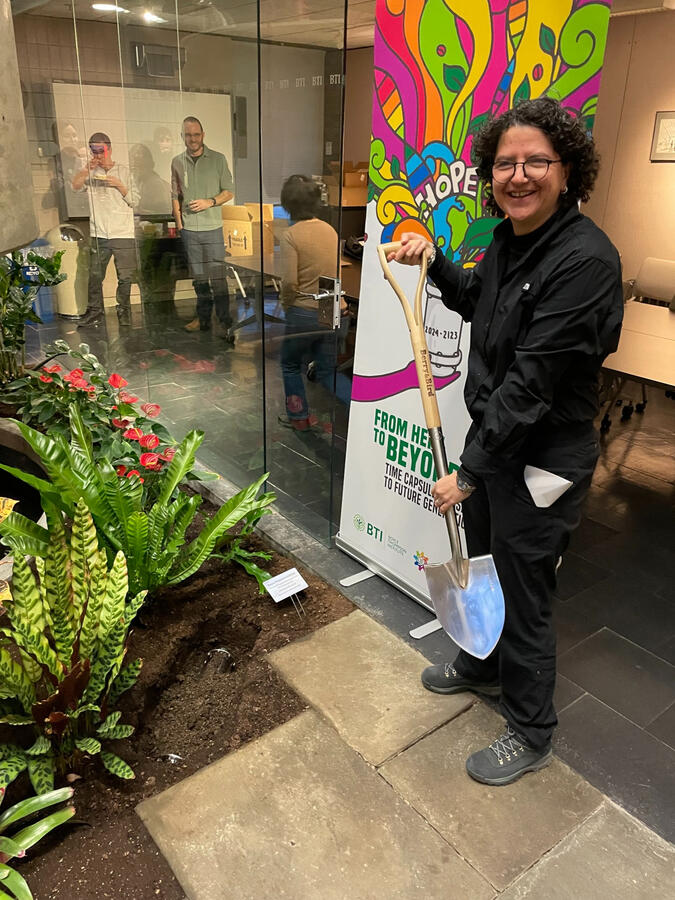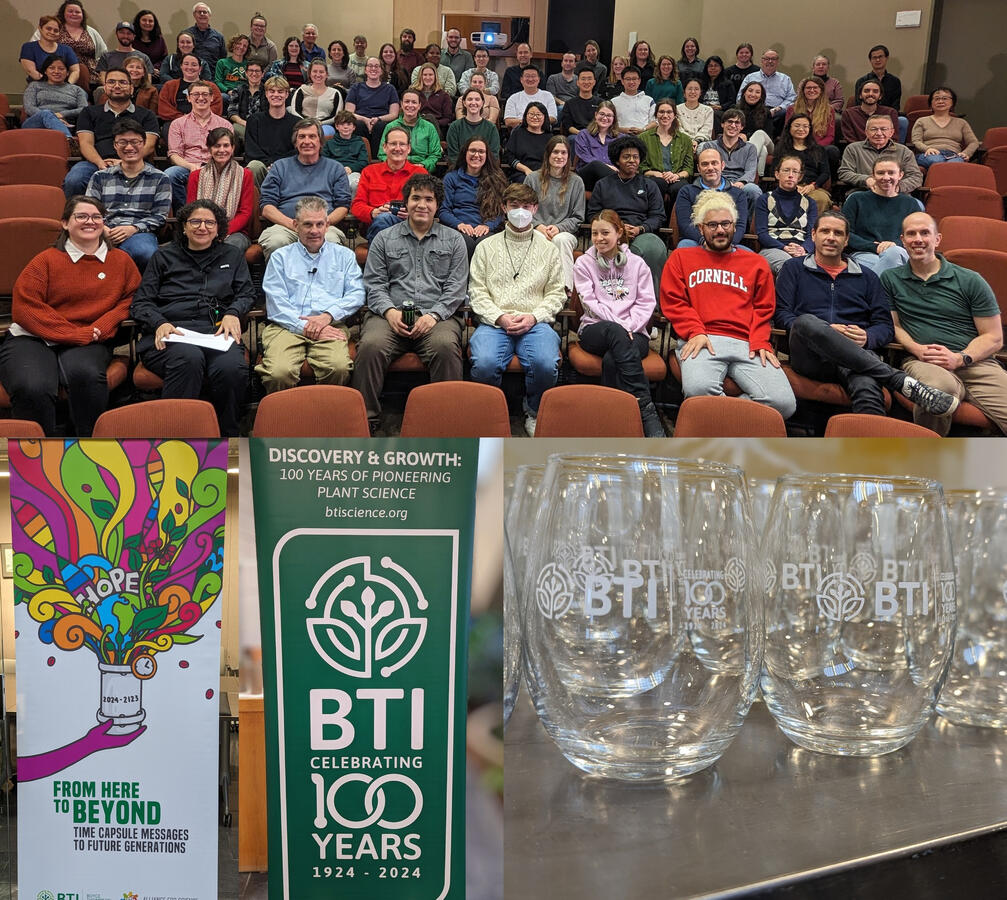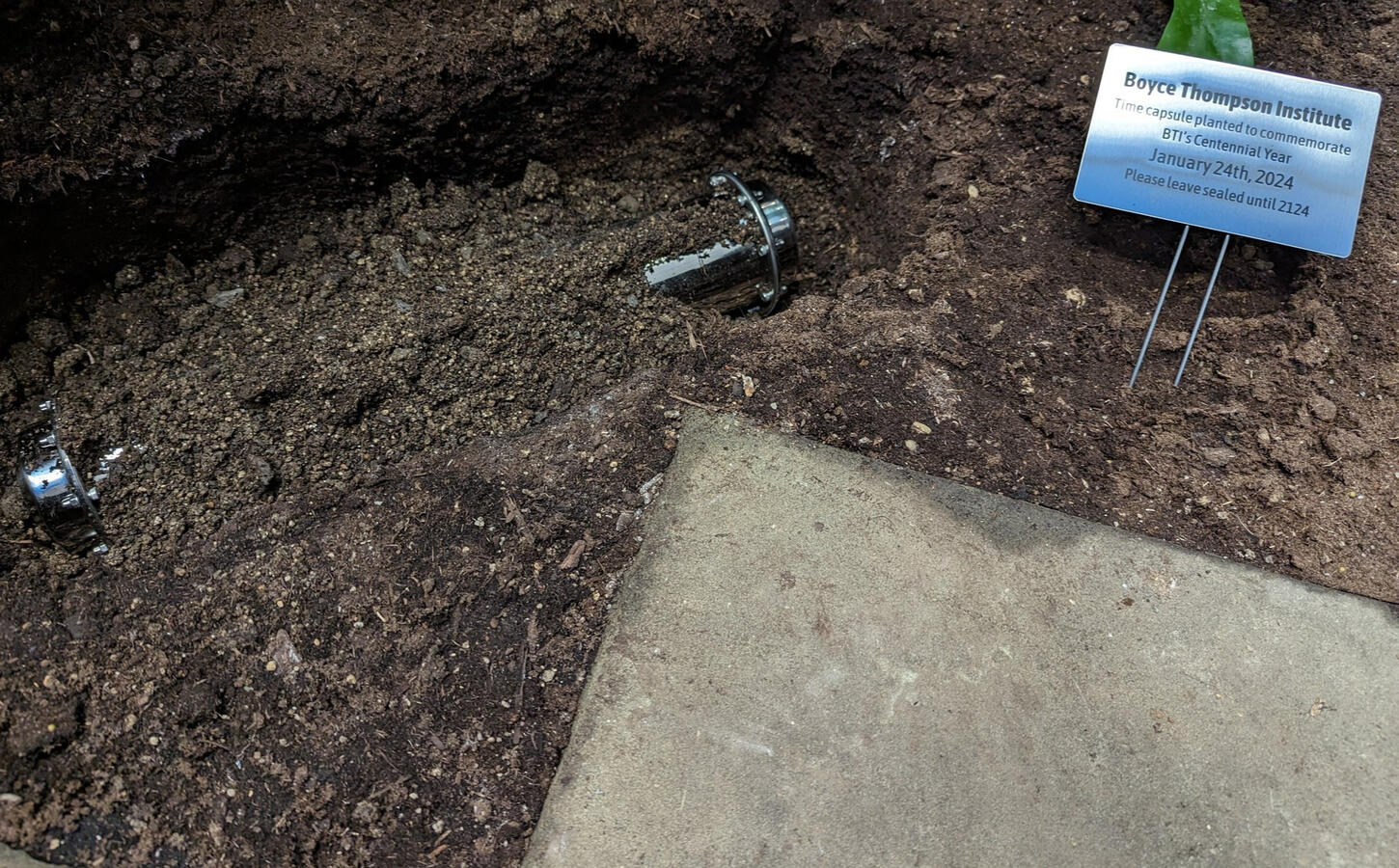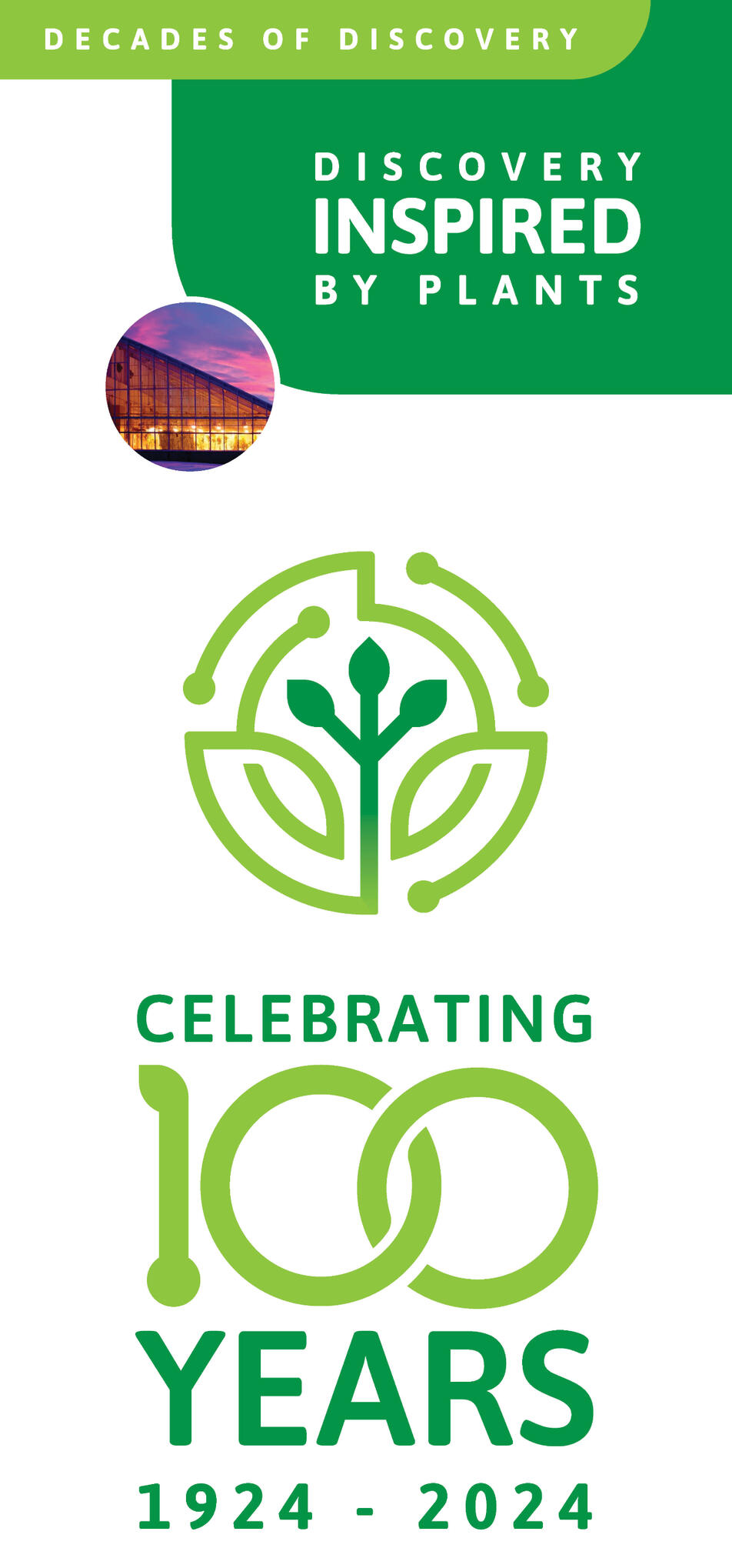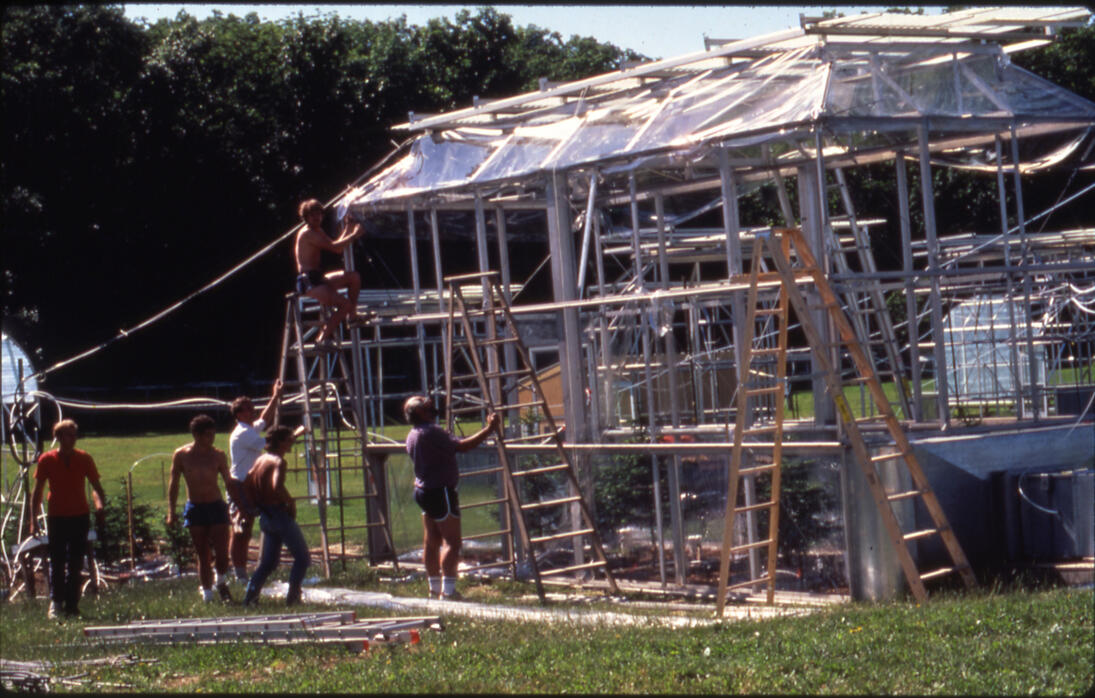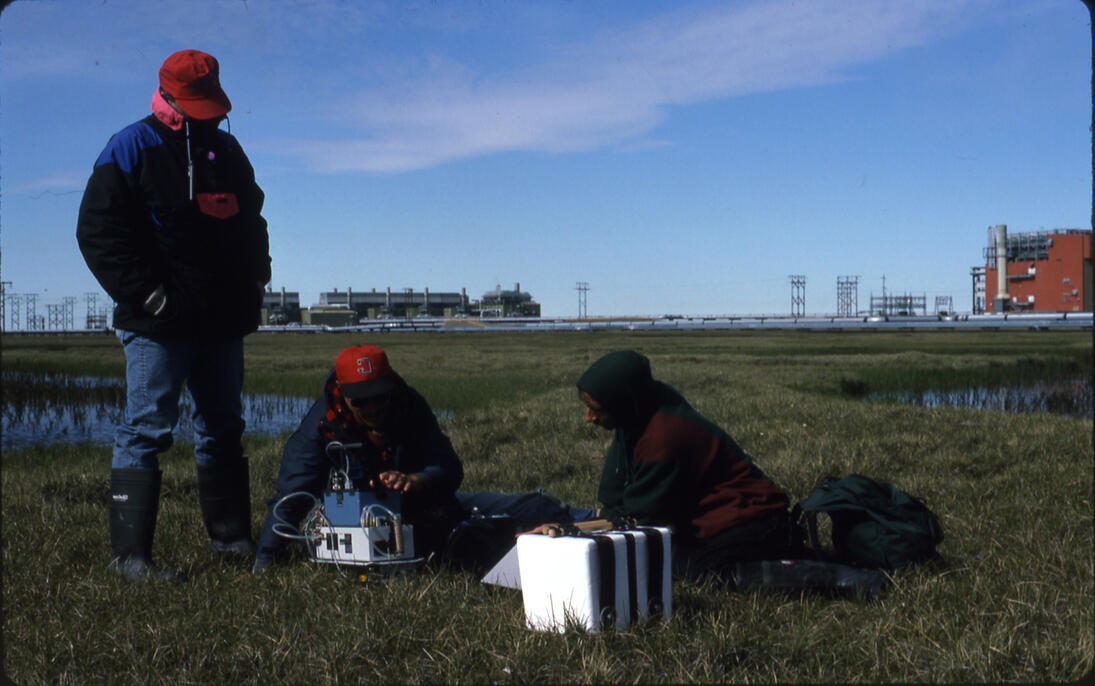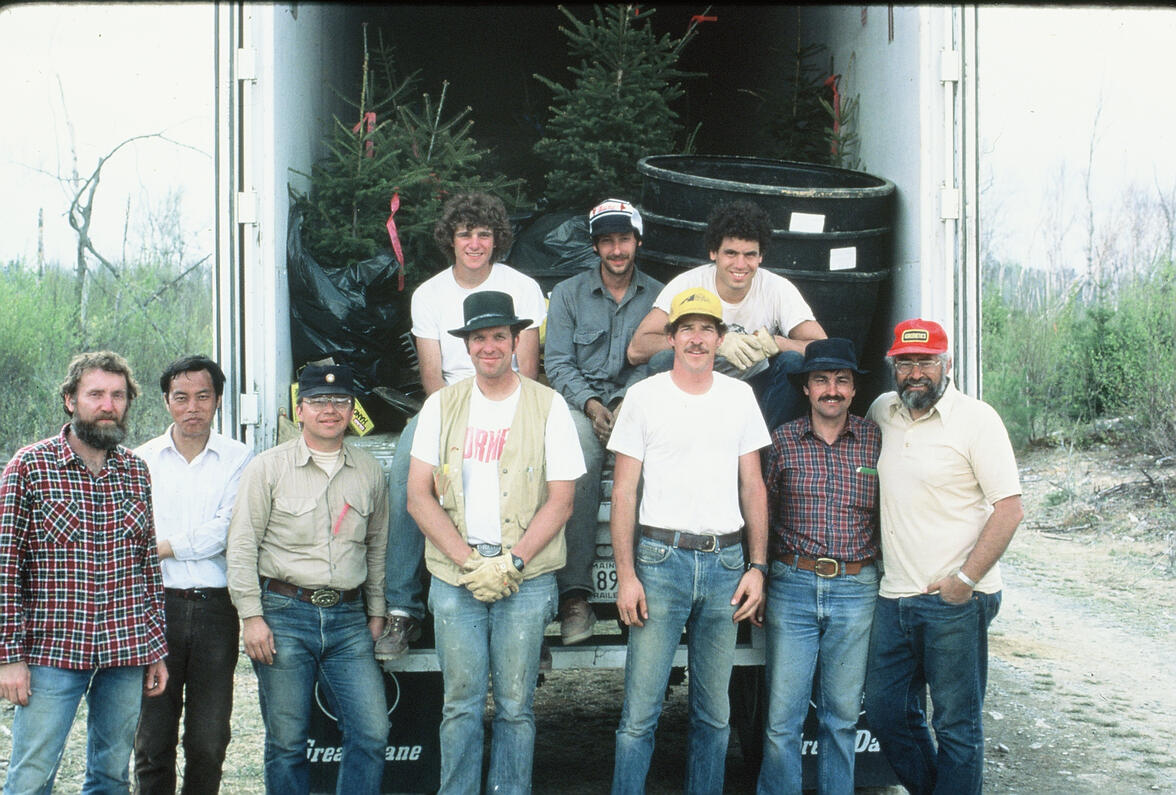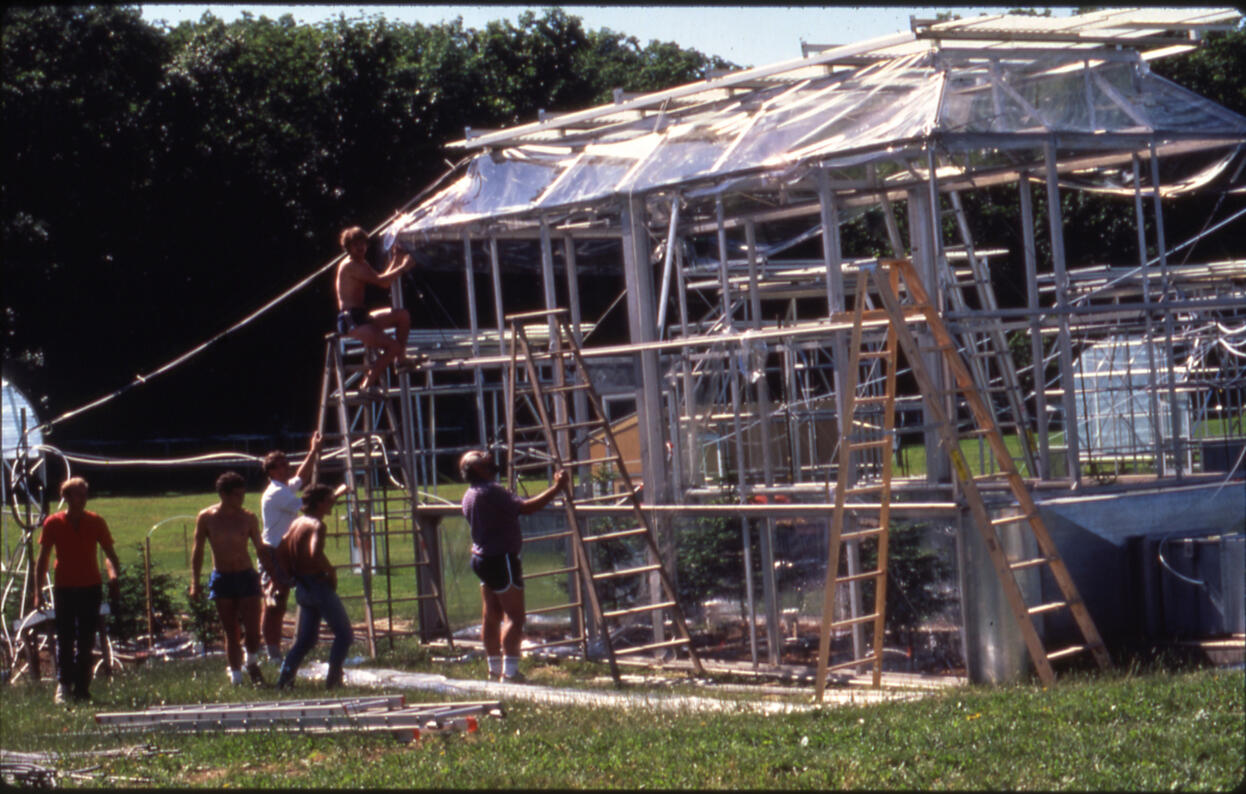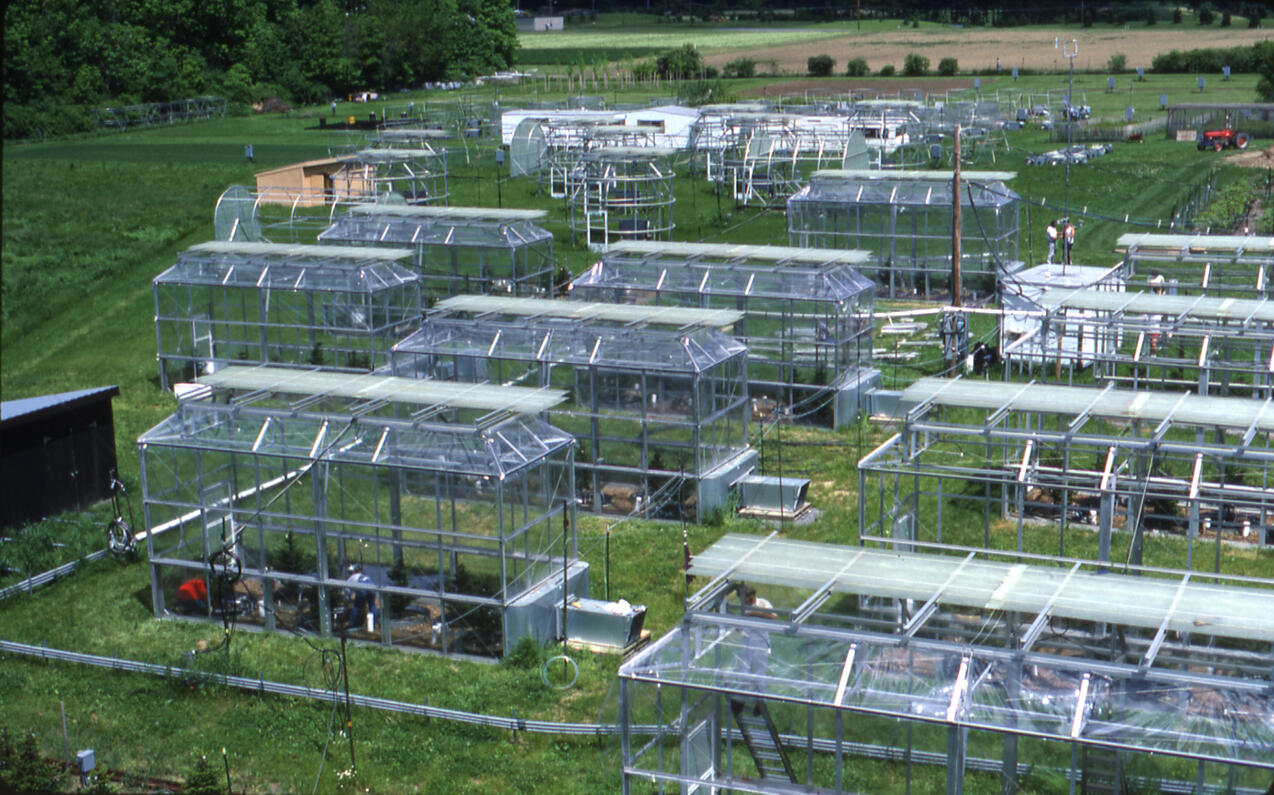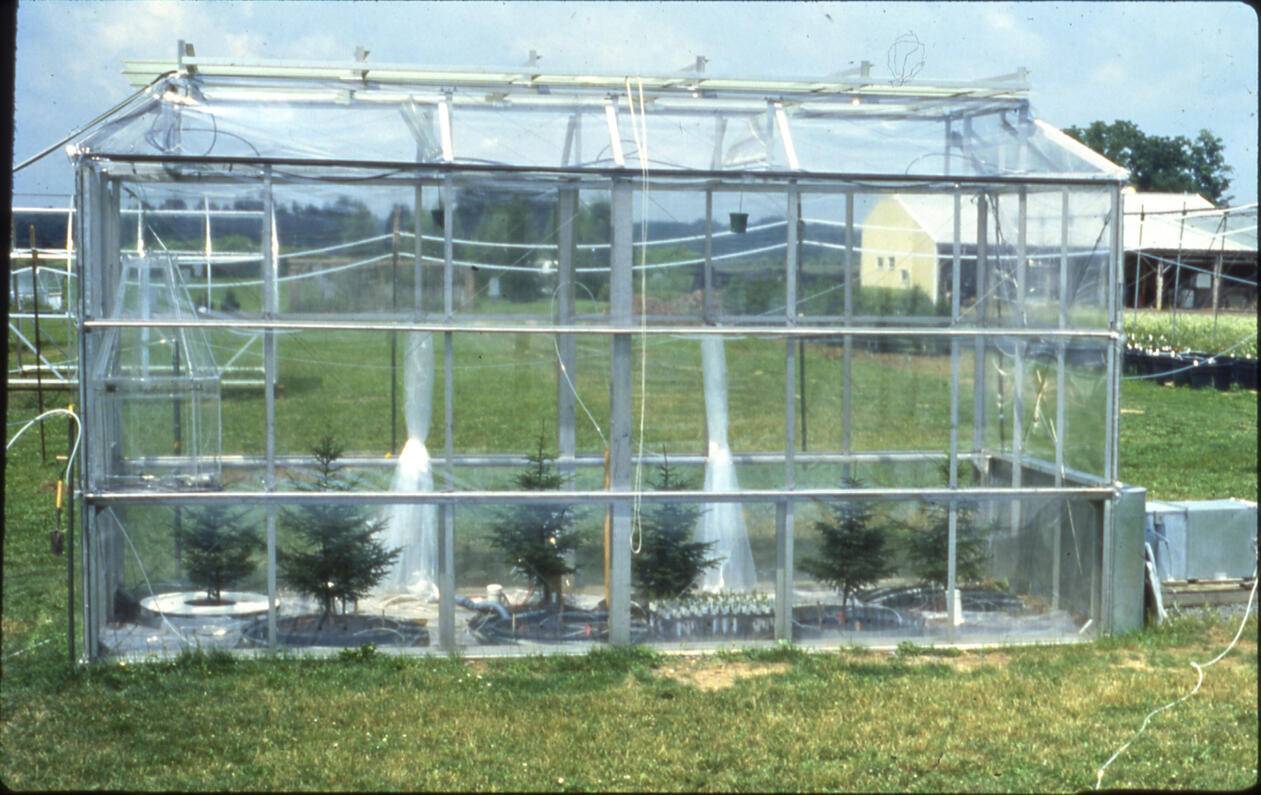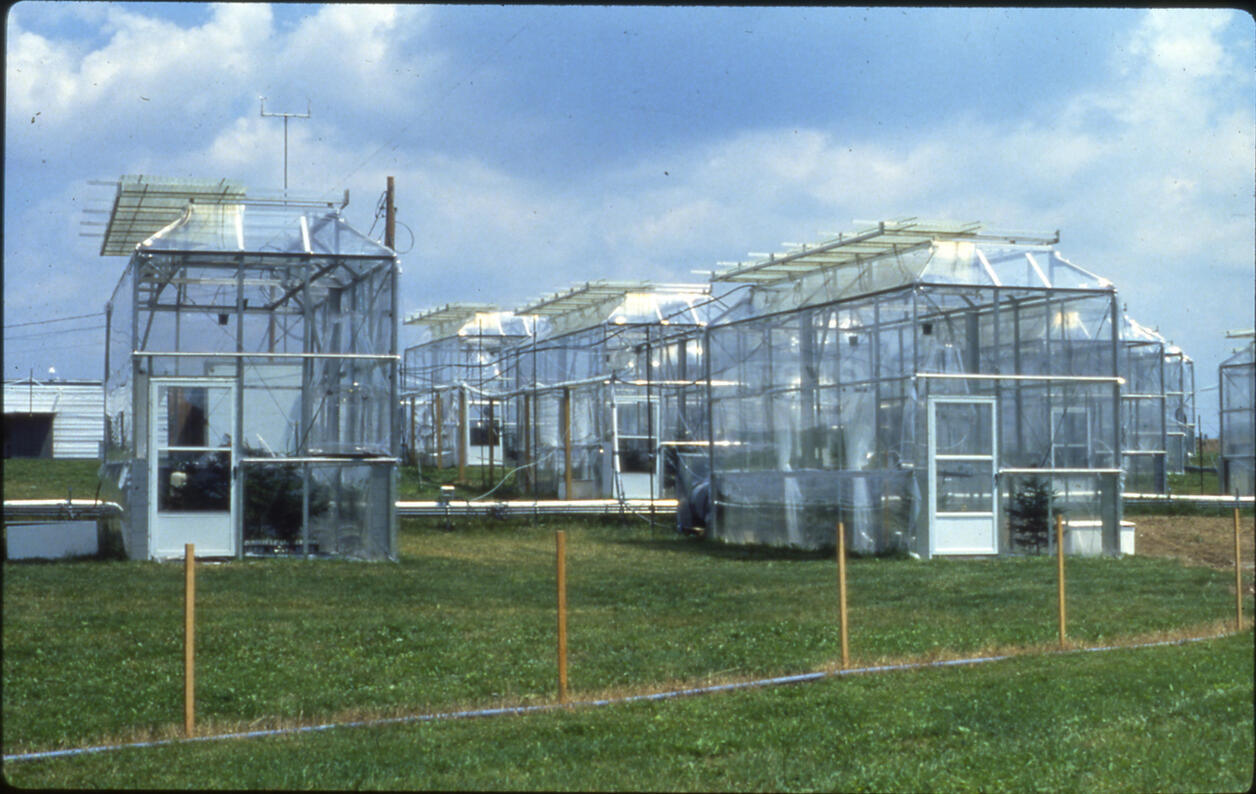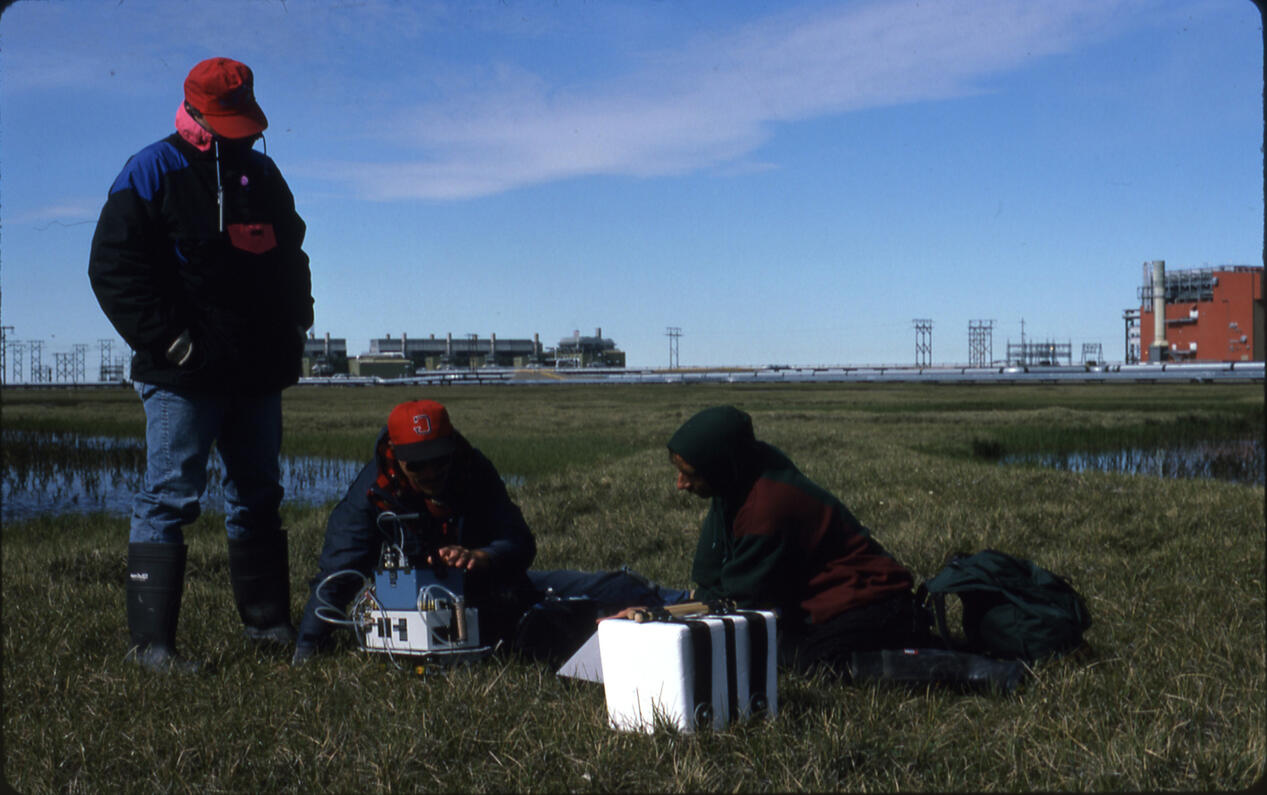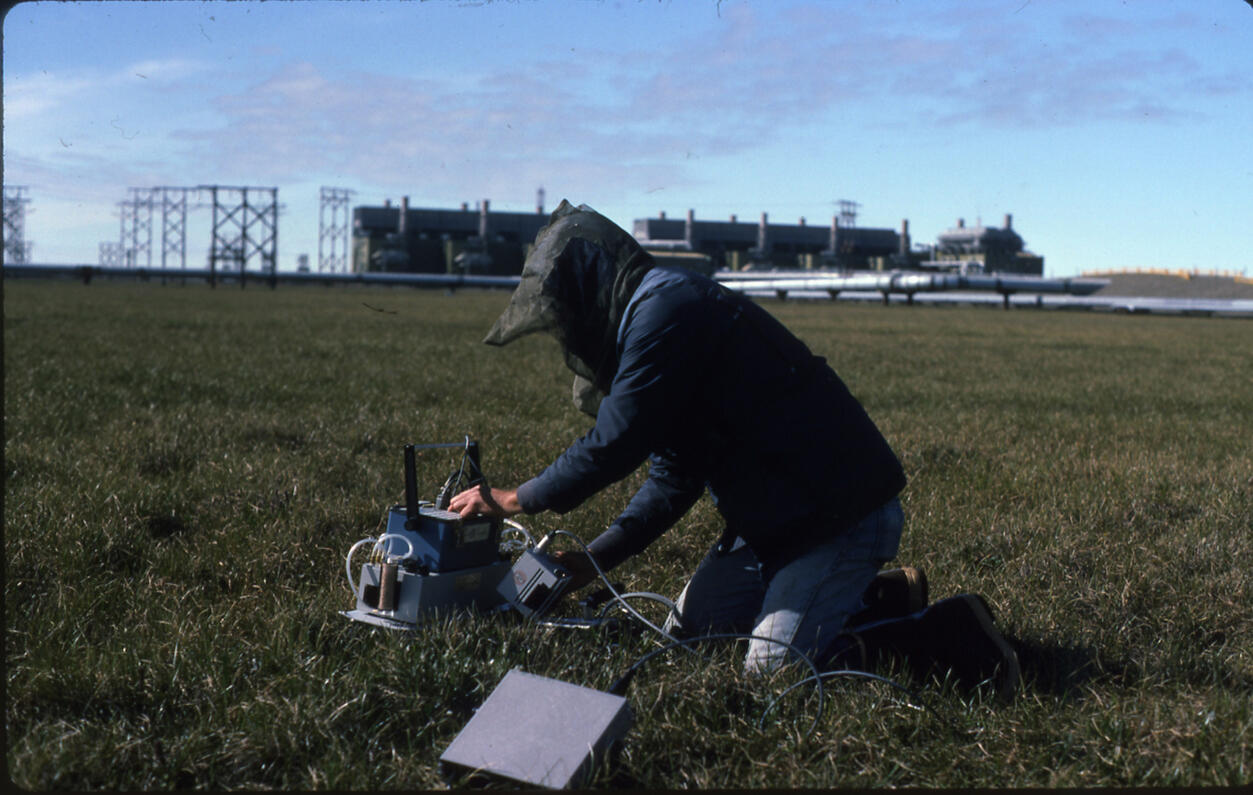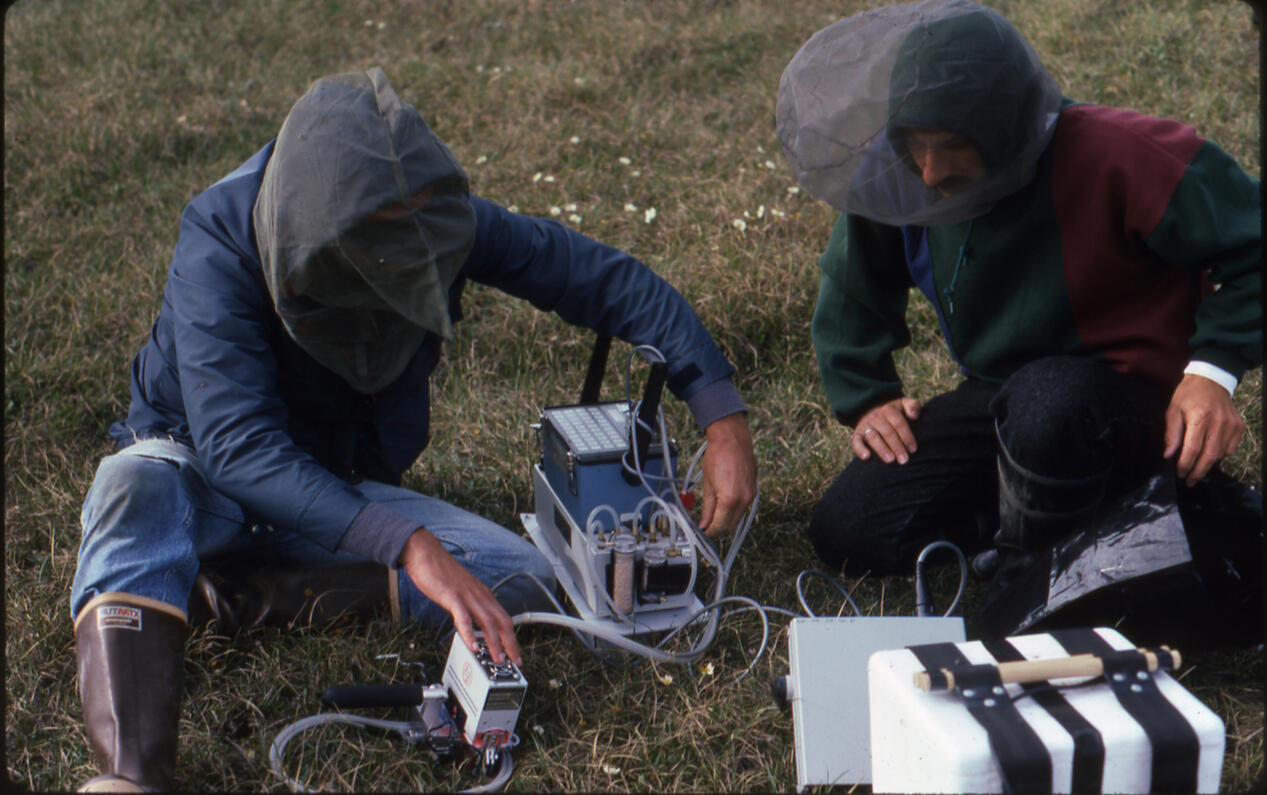
Discovery & Growth: 100 Years of Pioneering Plant Science
2024 Centennial Celebration
Join us in celebrating Boyce Thompson Institute's centennial anniversary. We have planned a series of events to honor our legacy, recognize groundbreaking milestones, and envision the future of plant research. Come be part of this historic celebration!
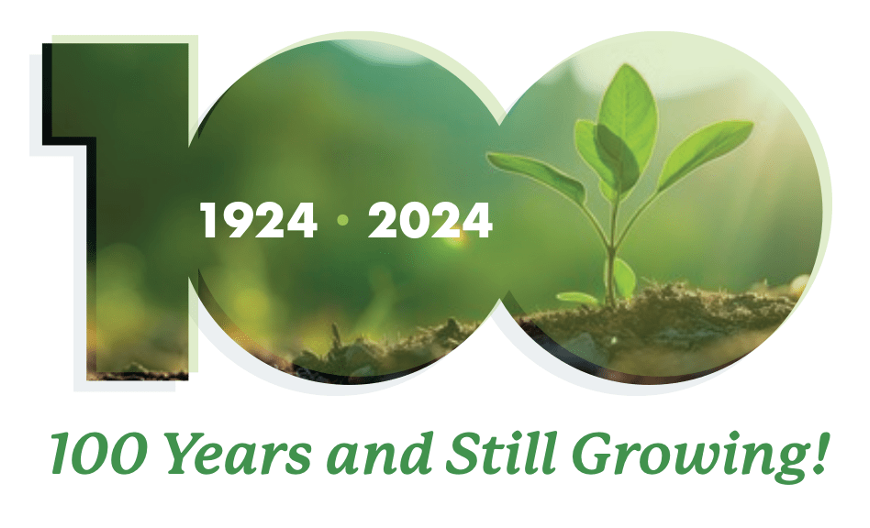
Enjoy stories directly from members of the BTI community.
About BTI
The Boyce Thompson Institute is a leader in plant science research, dedicated to advancing our understanding of plants for a sustainable future. Our work ranges from exploring plant biology to addressing global environmental challenges.Our centennial theme, ‘Discovery & Growth: 100 Years of Pioneering Plant Science,’ celebrates our legacy and looks forward to future innovations in plant science.Throughout the year, we're hosting a series of events, each marking a different aspect of our centennial celebration. These events progress from reflecting on BTI’s rich history to showcasing current research and future aspirations.
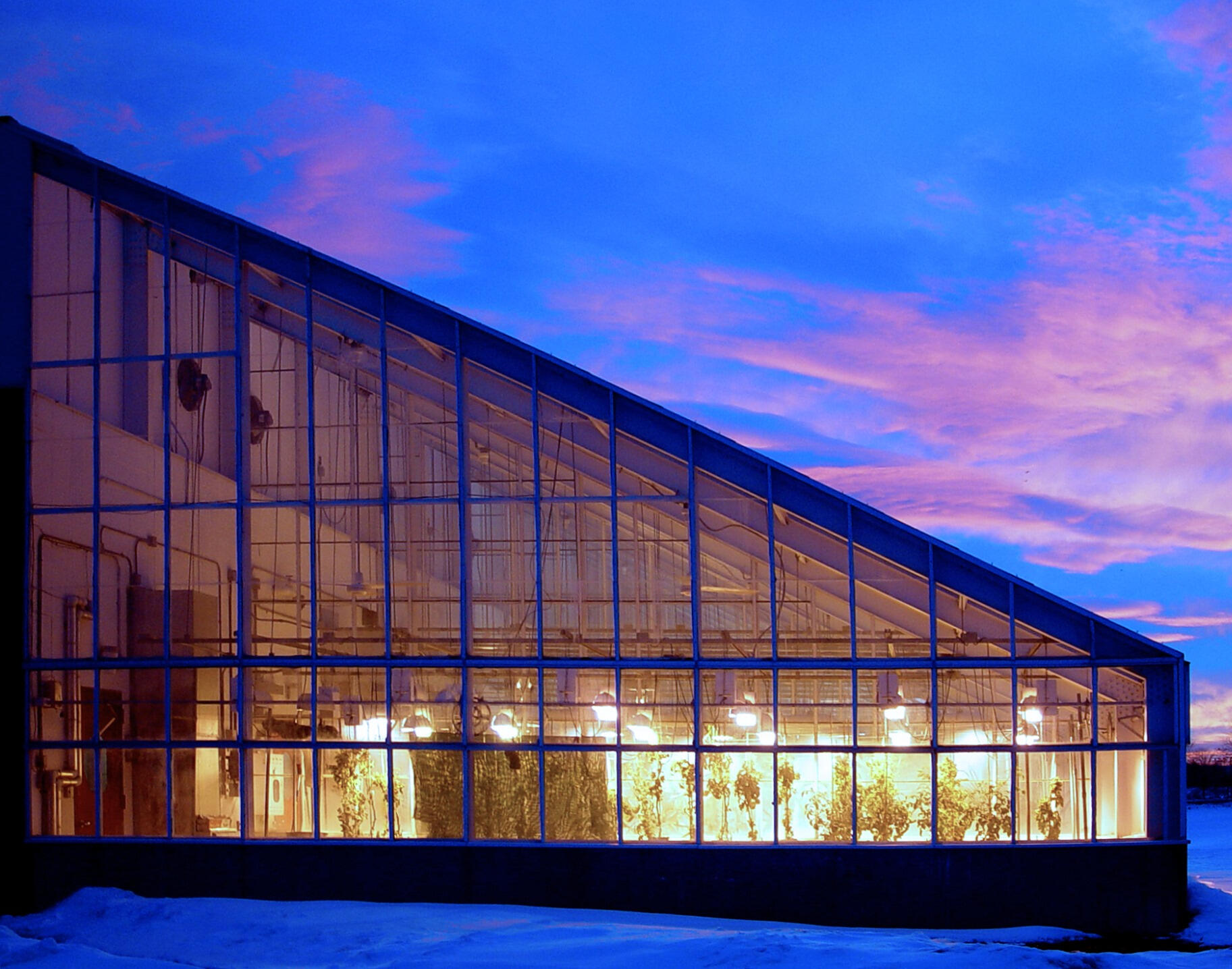
A Future Rooted in Discovery and Growth
As BTI steps into its next century, it does so with a renewed spirit of innovation and an expanded vision. The Institute looks forward to continuing its tradition of pioneering research, with a focus on addressing contemporary challenges such as sustainable agriculture, climate change, and food security.In this pivotal year, BTI not only looks back with pride but also looks forward with anticipation, ready to embark on new paths of discovery and to continue making significant contributions to the world of plant science.
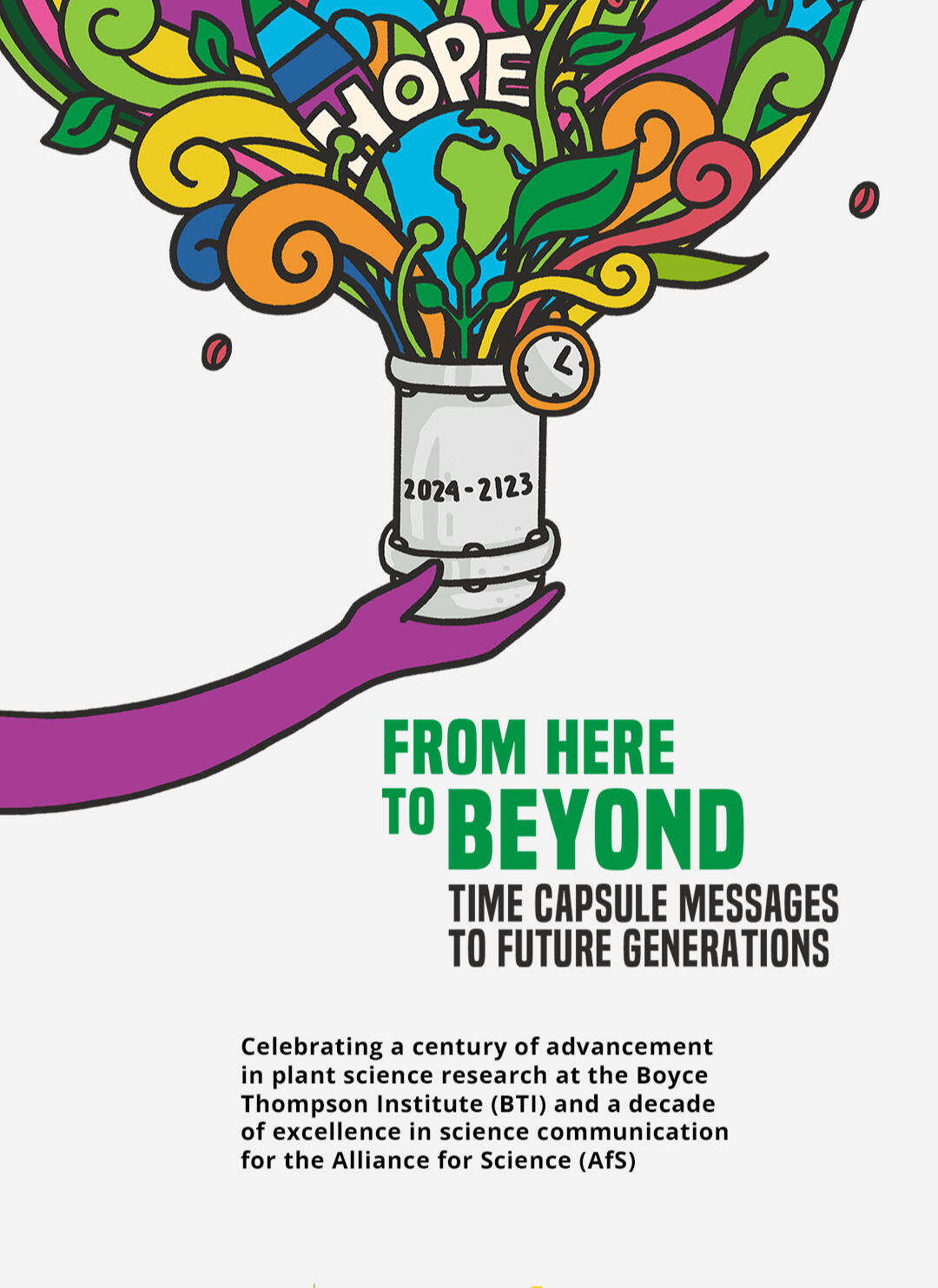
Time Capsule
January 24th, 4:00pm
Boyce Thompson Institute Atrium
533 Tower Rd, Ithaca, NY 14853
Join Boyce Thompson Institute to celebrate the start of our Centennial celebrations as we honor 100 years of research and BTI’s past, present, and future with the planting of a time capsule in BTI’s atrium. Don’t miss a toast by President Silvia Restrepo and an exciting announcement about BTI’s future!
Speaker Series
Feb - July
BTI Auditorium
533 Tower Rd, Ithaca, NY 14853
Come be an honored guest at our engaging lecture series. We have invited inspiring leaders in fields across plant science to share their journey and insights.
The presentations will last about an hour, with time for questions.Click below to join on Zoom when event begins:Ed Buckler – March 7, 10 am
Rob Last – March 26
Zach Lippman - May 15
Dani Zamir - April 29
Adrienne Roeder - June 5
Jian-Min Zhou - July 15
Alexa Schmitz and Daniel Voytas– Summer Symposium August 8 and 9
Siobhan Brady - Sept 17
Sandra Knapp - Oct 10
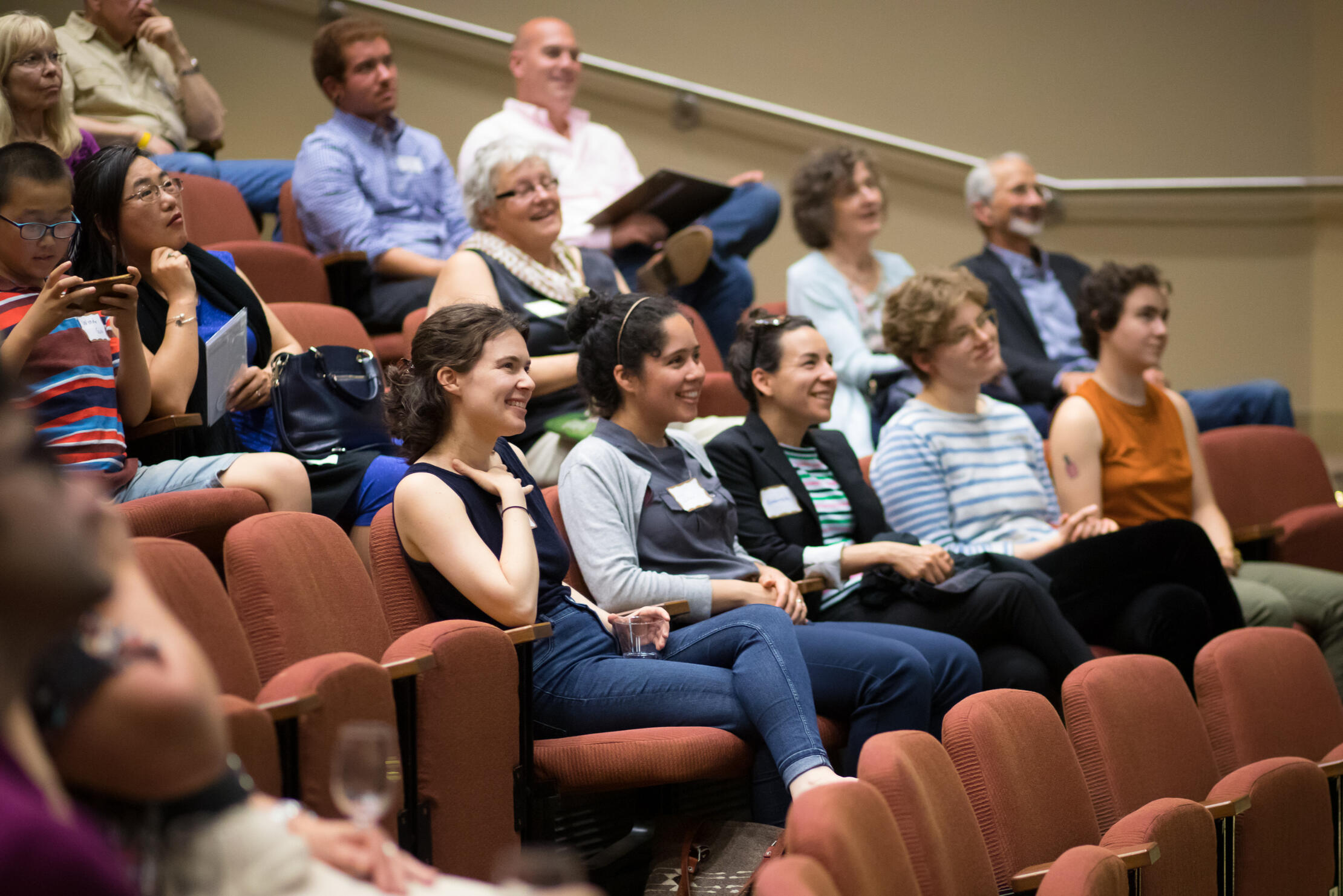
Please join us on Tuesday, September 17th, 2024, from 10-11am in the BTI Auditorium for the next speaker in our special Centennial Series, Siobhan Brady.
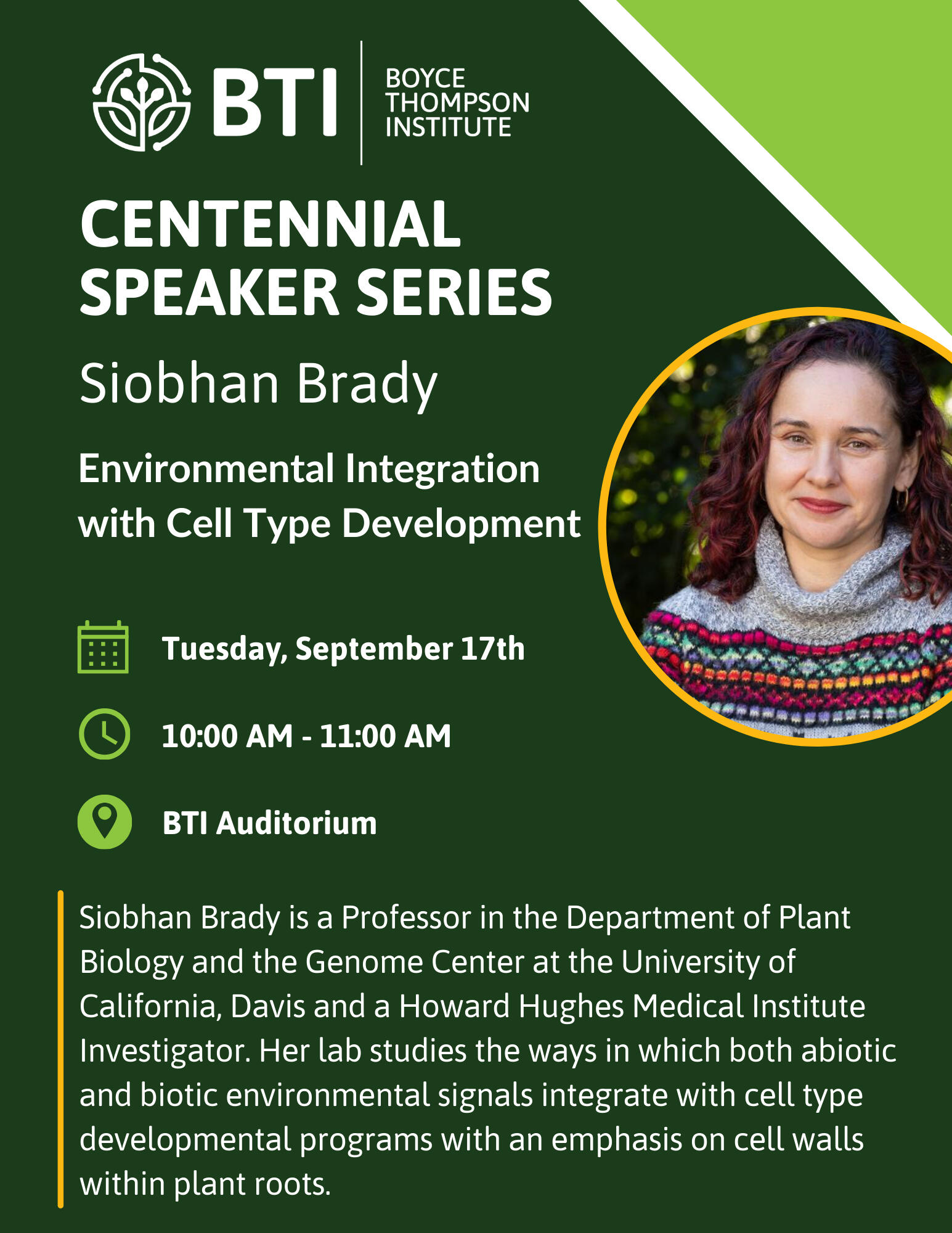
Please join us on Thursday, October 10th, 2024, from 10-11am in the BTI Auditorium for the next speaker in our special Centennial Series, Sandra Knapp.
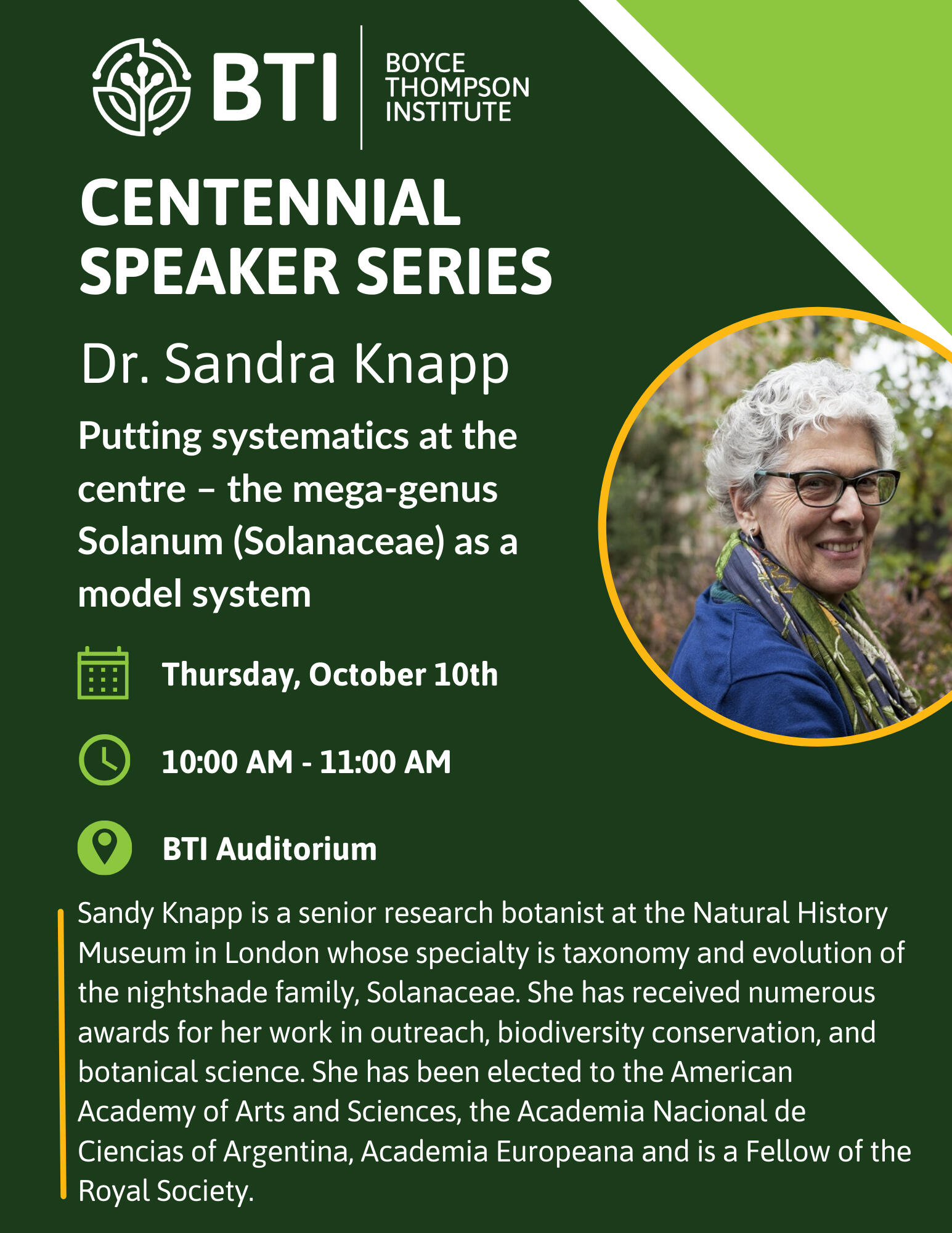
Please join us on Monday, July 15, 2024, from 11am-12:00pm in the BTI Auditorium for the next speaker in our special Centennial Series, Dr. Jian-Min Zhou.

Please join us on Thursday, March 7, 2024, from 10-11:00am in the BTI Auditorium for the first speaker in our special Centennial Series, Dr. Ed Buckler.

Please join us on Wednesday, May 15th, 2024, from 10-11:00am in the BTI Auditorium for our next speaker in our special Centennial Series, Dr. Zach Lippman.
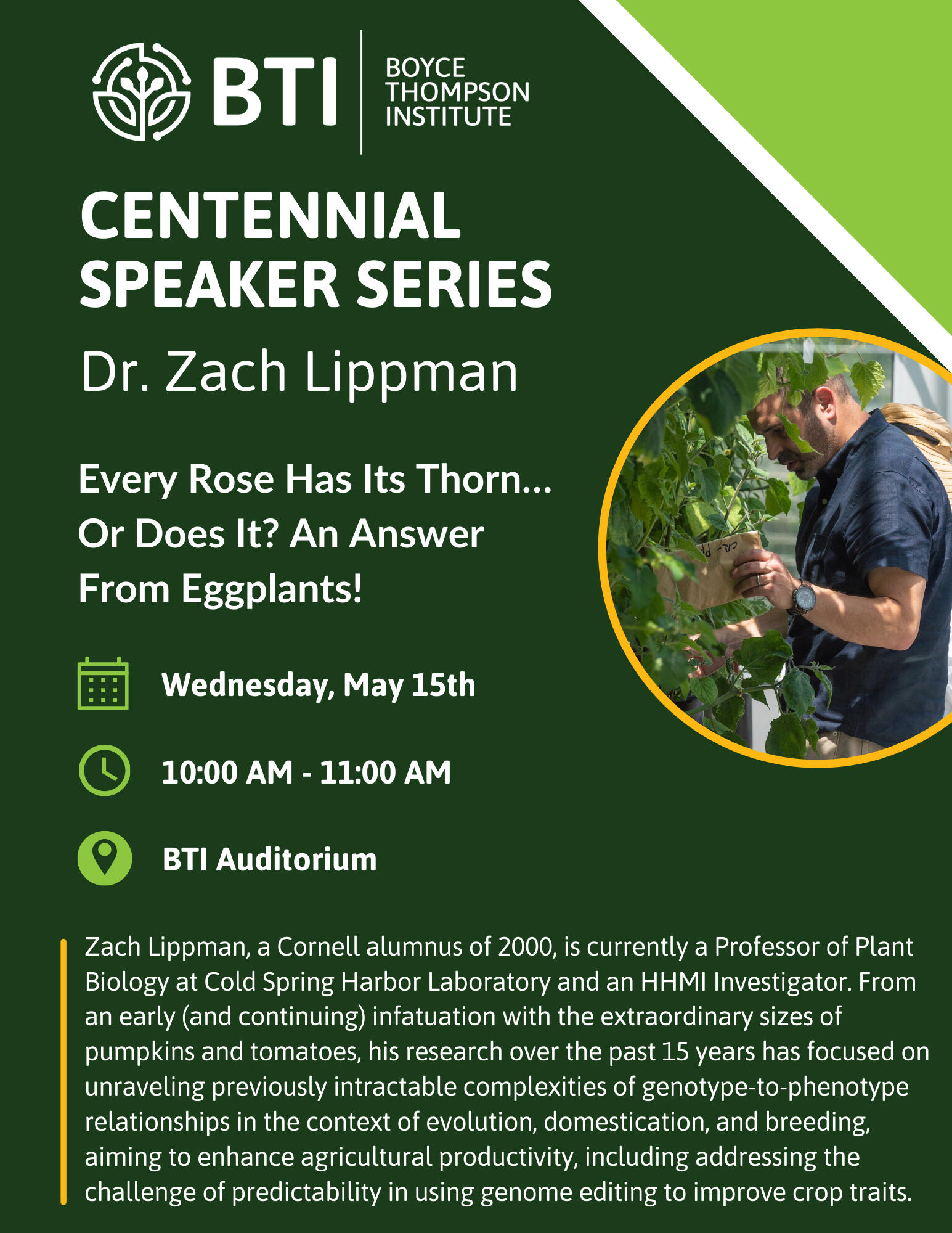
Please join us on Monday, April 29, 2024, from 4-5pm in the BTI Auditorium for the next speaker in our special Centennial Series, Dr. Dani Zamir.
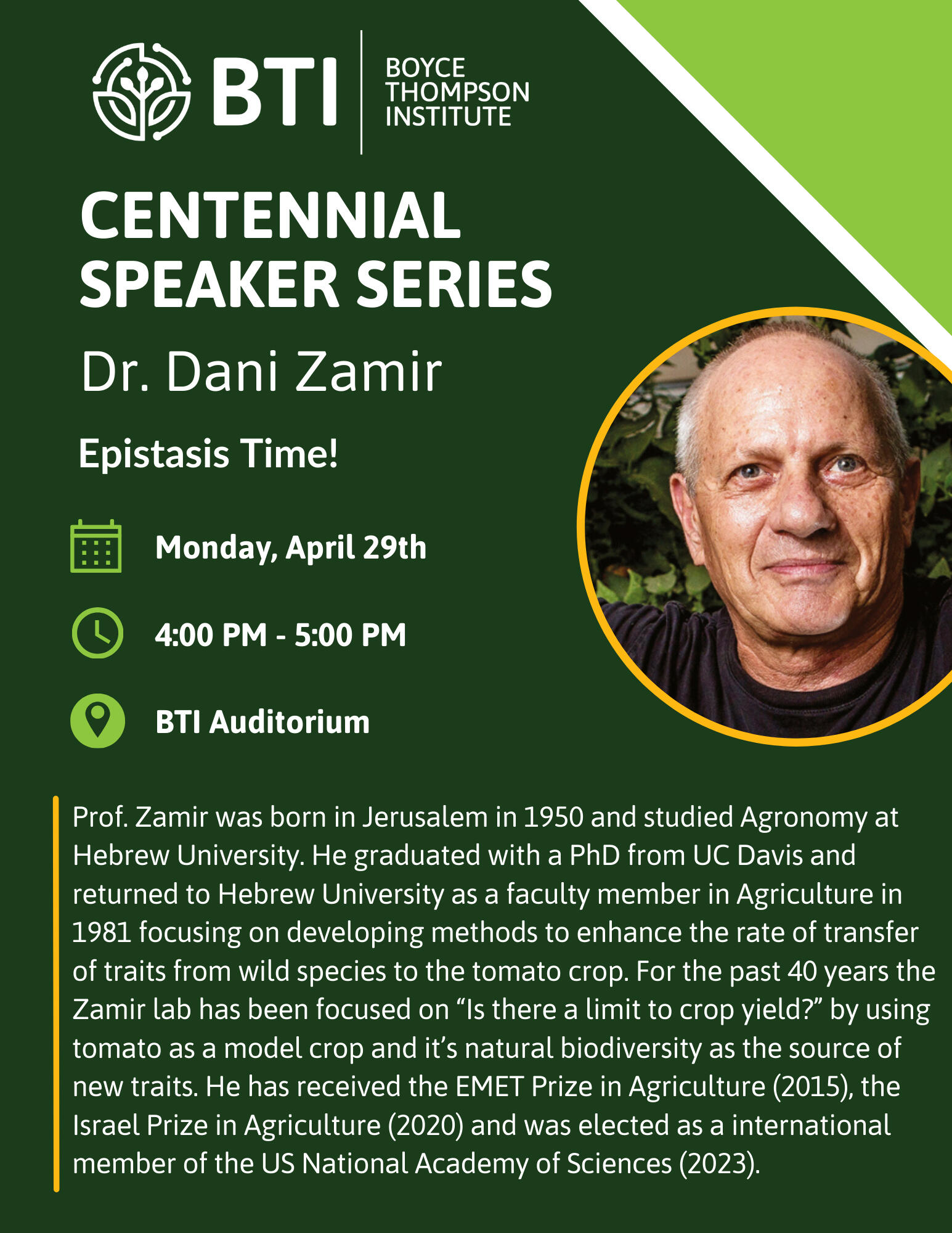
Please join us on Wednesday, June 5, 2024, from 10-11pm in the BTI Auditorium for the next speaker in our special Centennial Series, Dr. Adrienne Roeder.

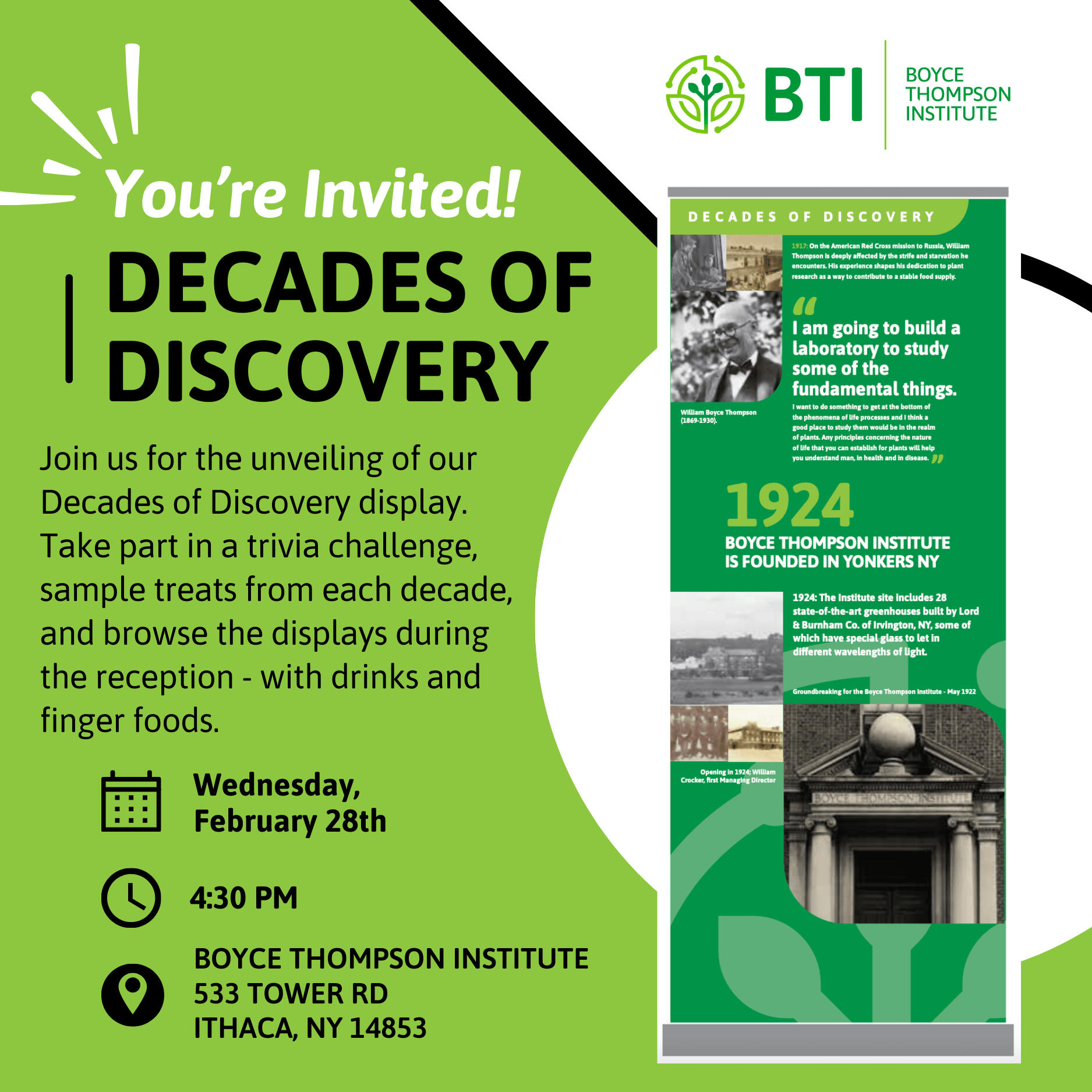
Decades of Discovery
February 28th, 4:30pm
BTI Auditorium
533 Tower Rd, Ithaca, NY 14853
Join us for the unveiling of our Decades of Discovery display. 100 years of groundbreaking research and significant milestones are visually represented in an engaging format, narrating the story of BTI's relentless pursuit of knowledge.
Take part in an interactive trivia challenge, sample treats from each decade, and browse the displays during the reception - featuring drinks and finger foods.
Click to explore BTI's history!
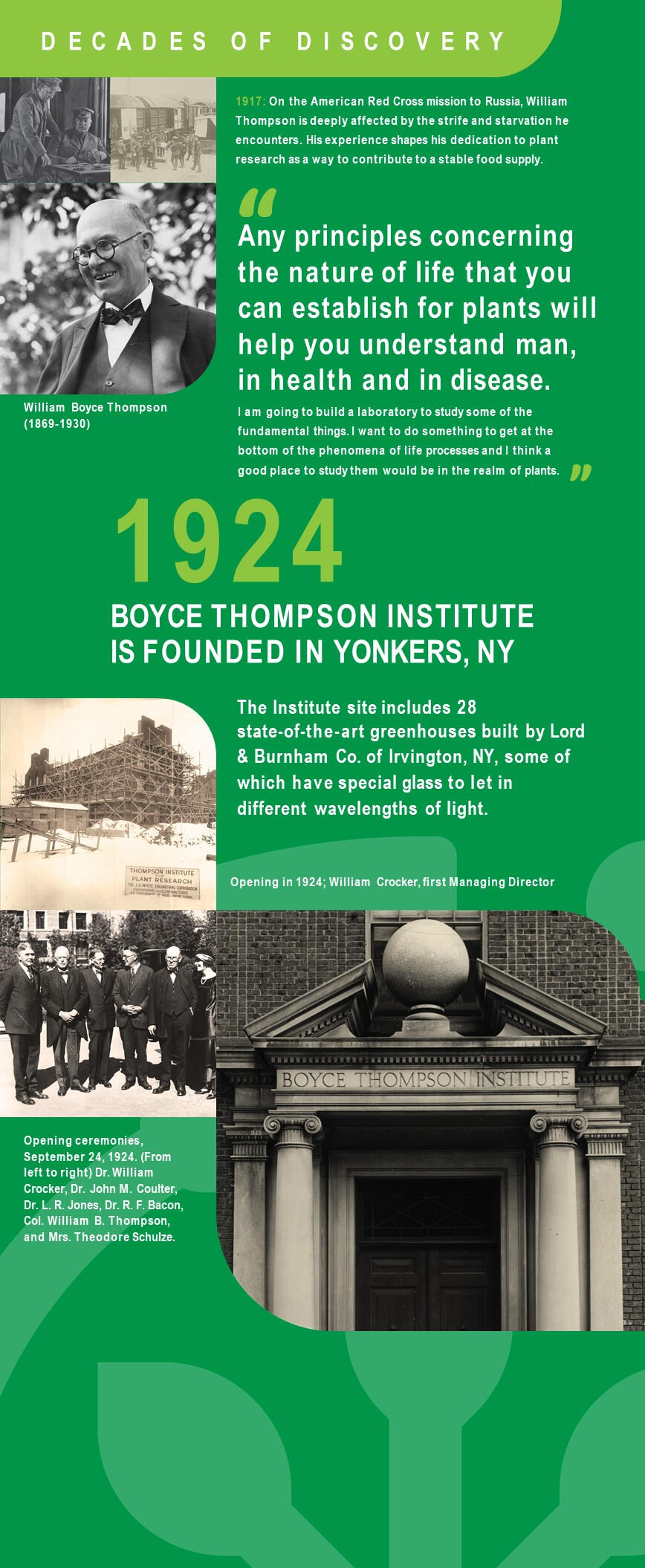
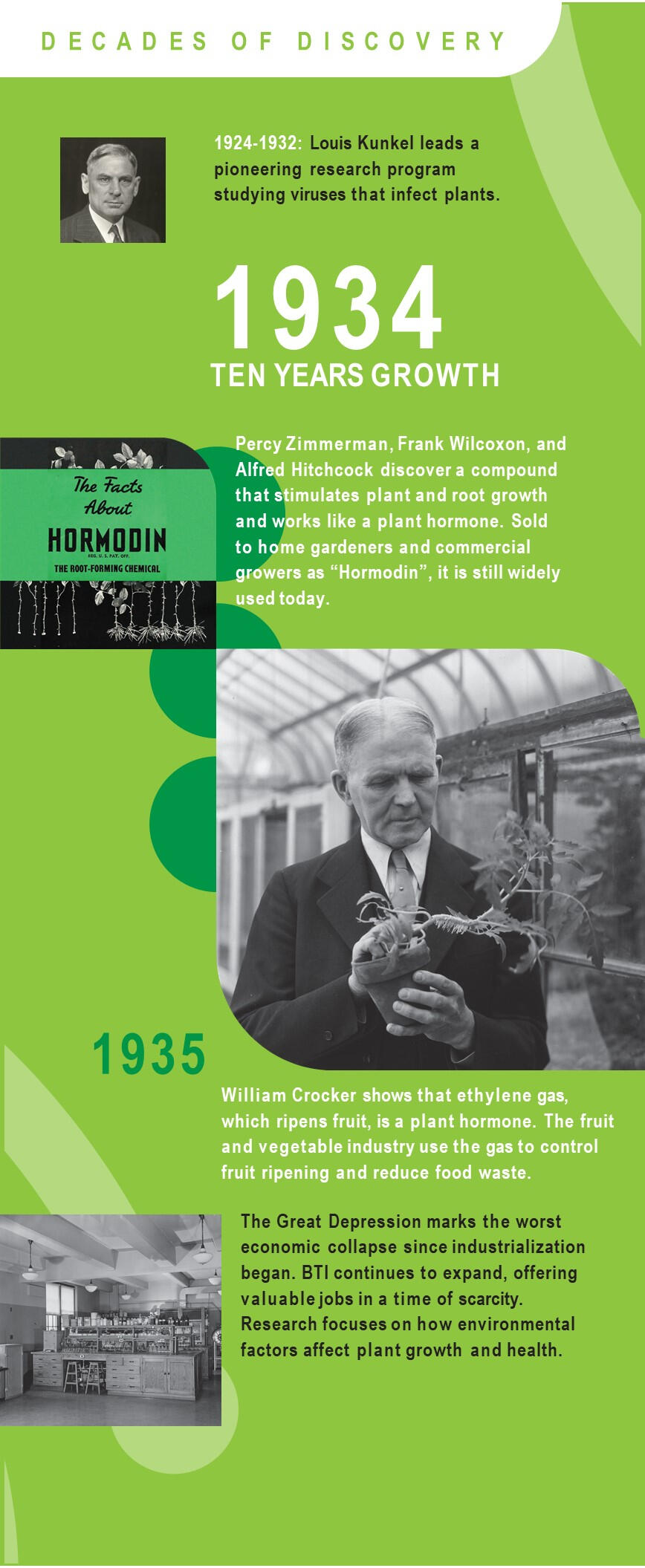
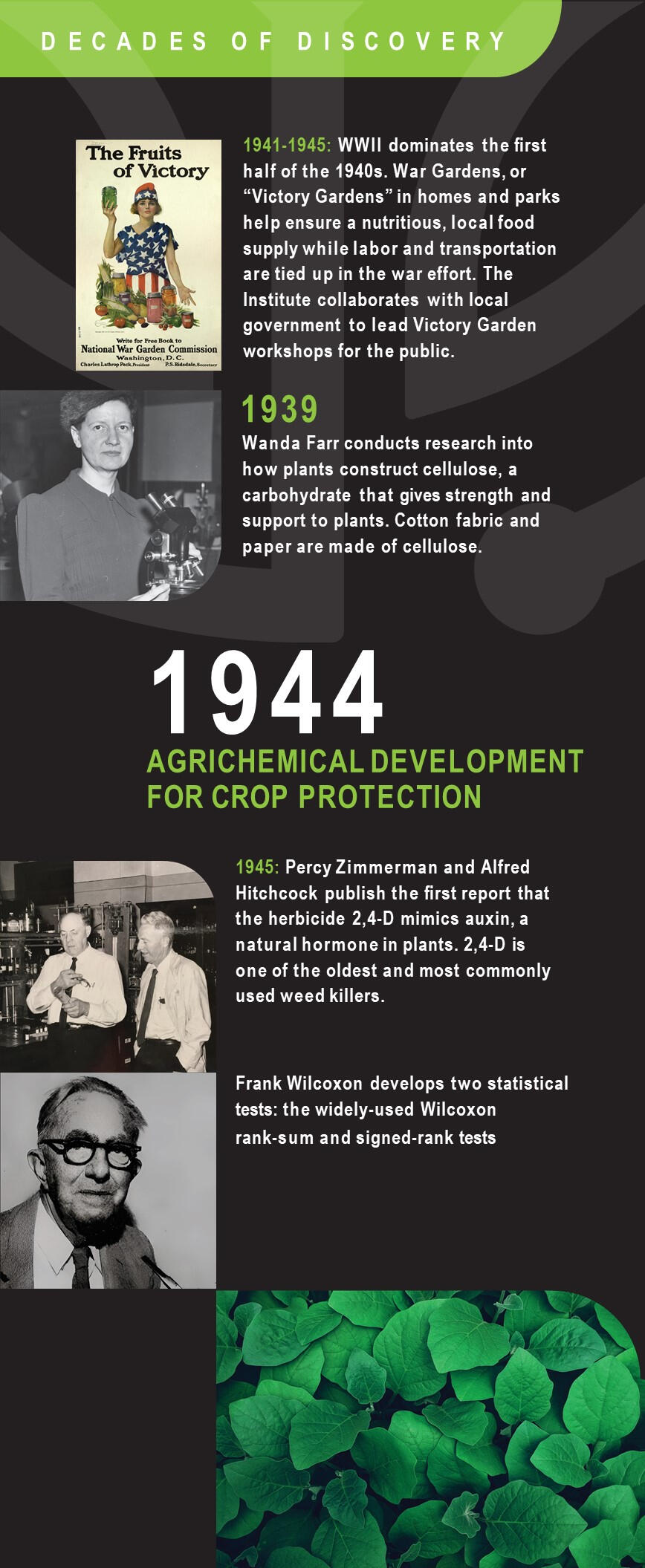
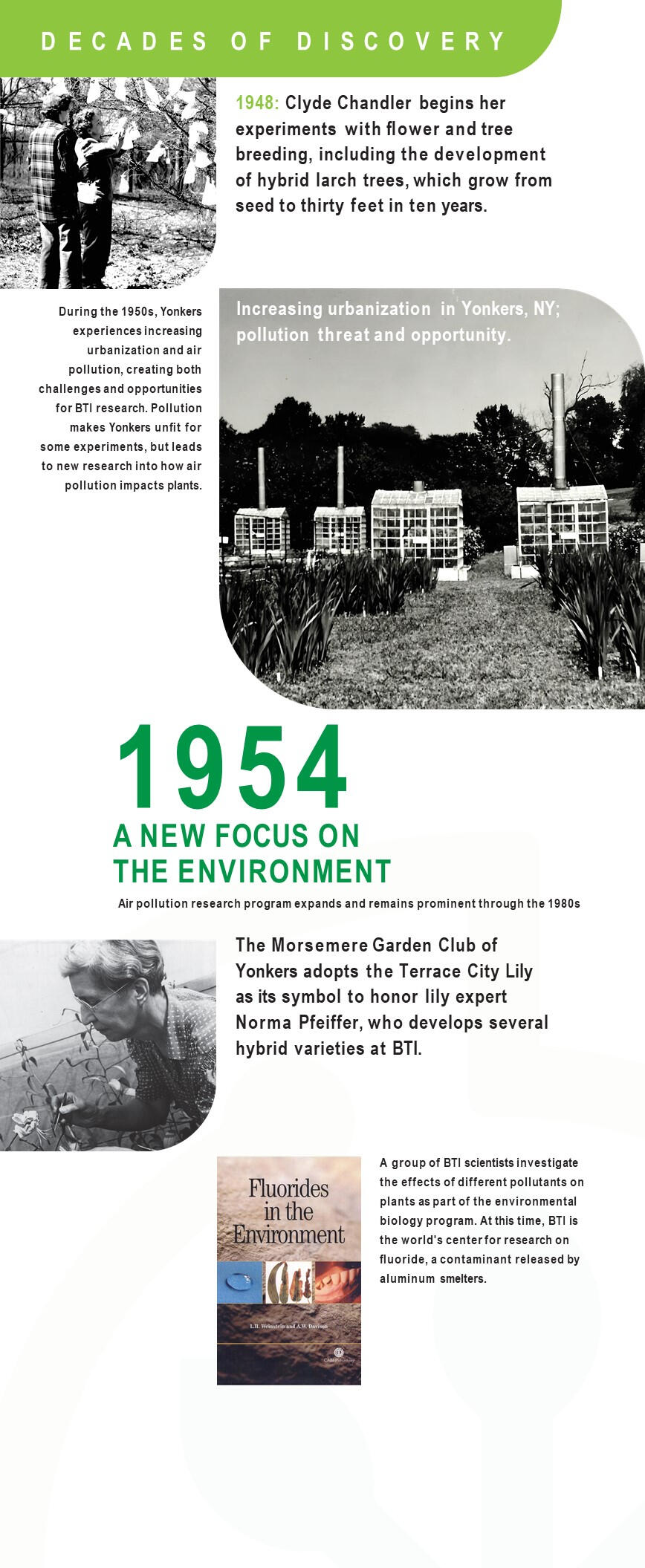
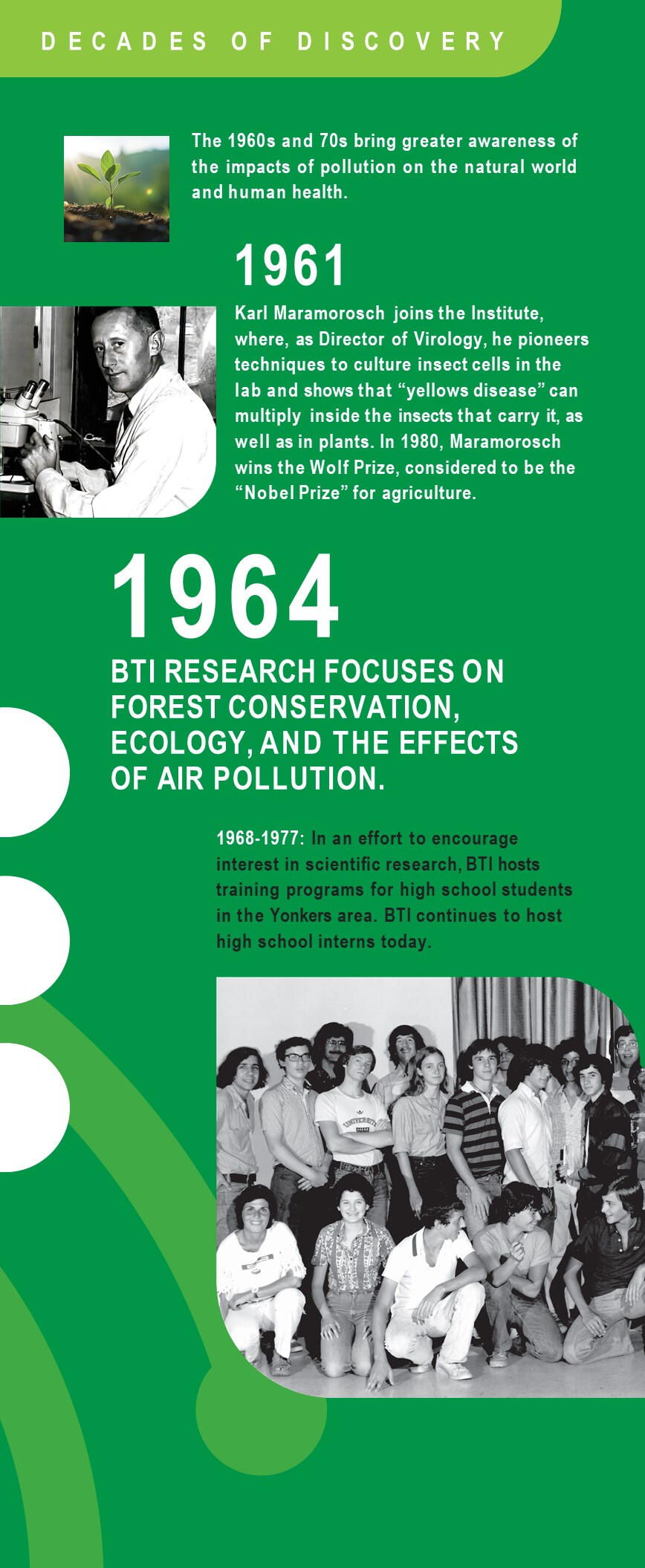
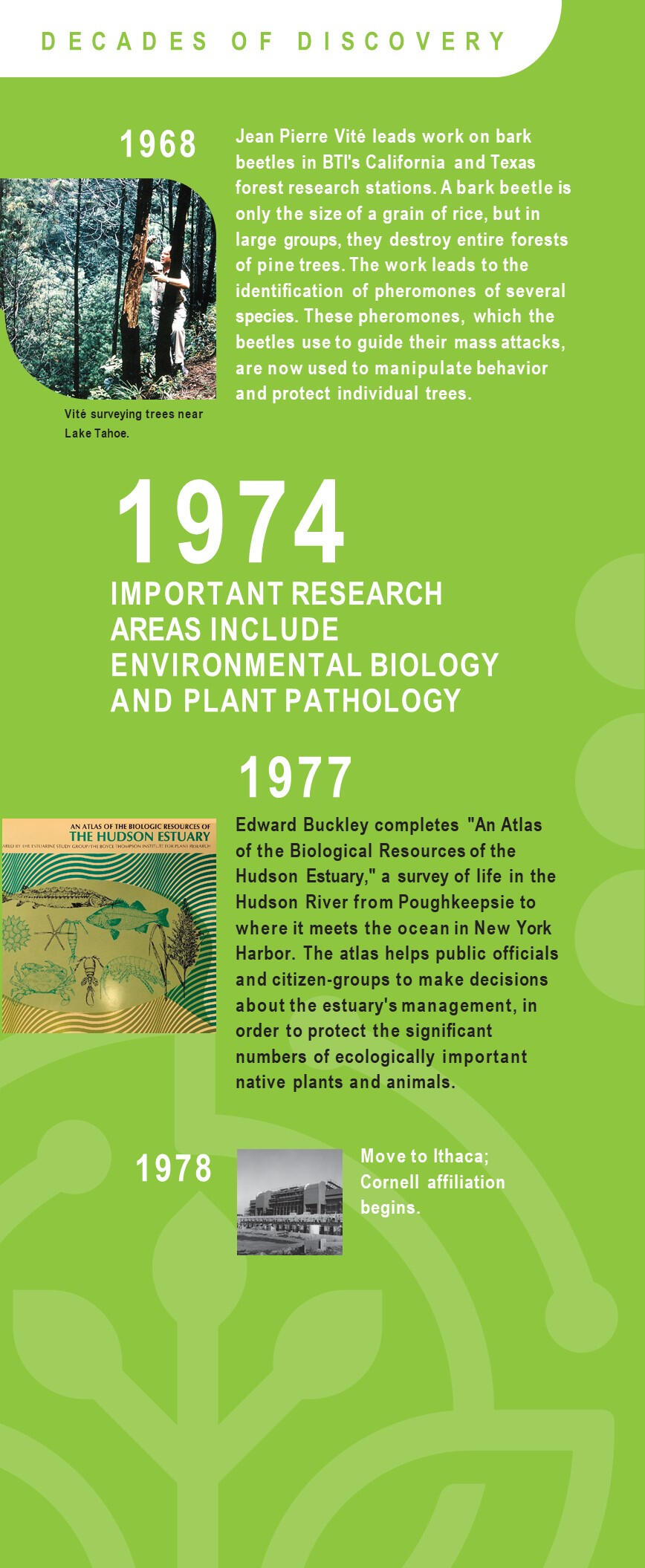
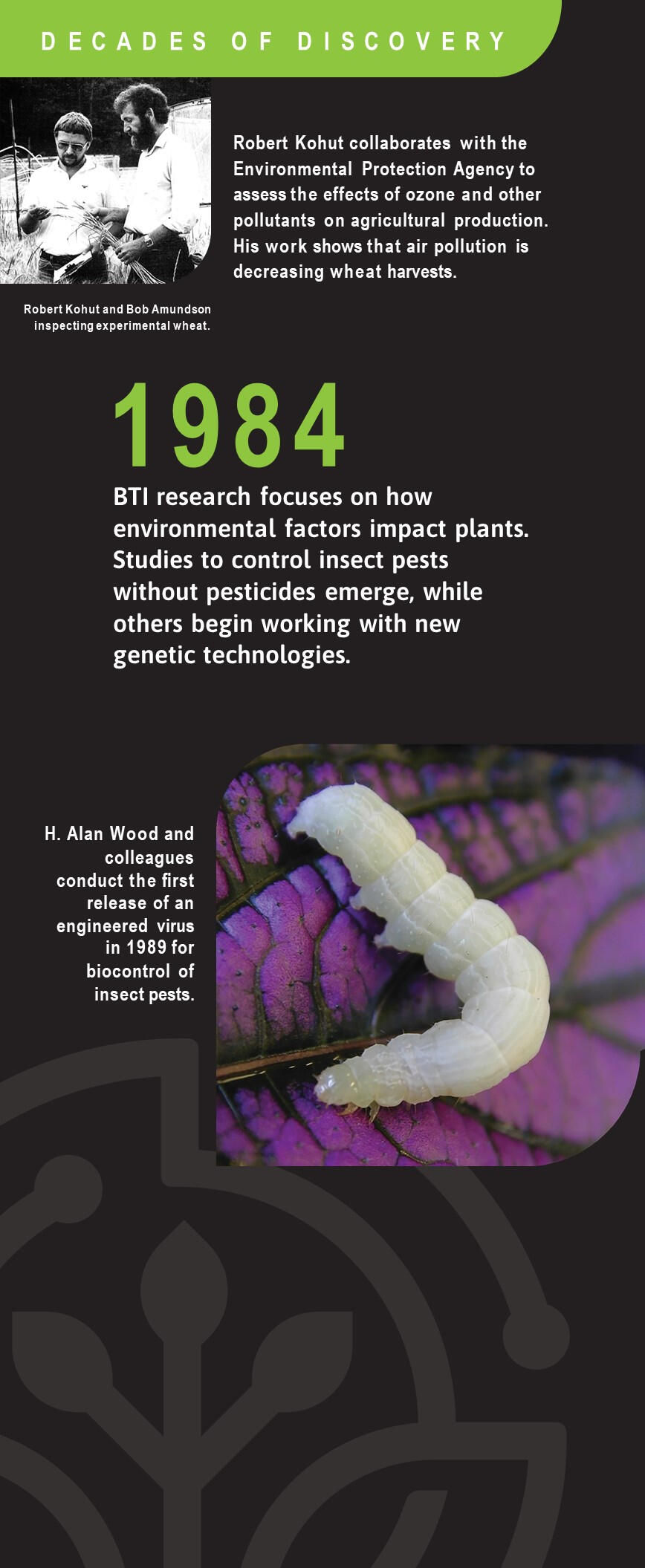
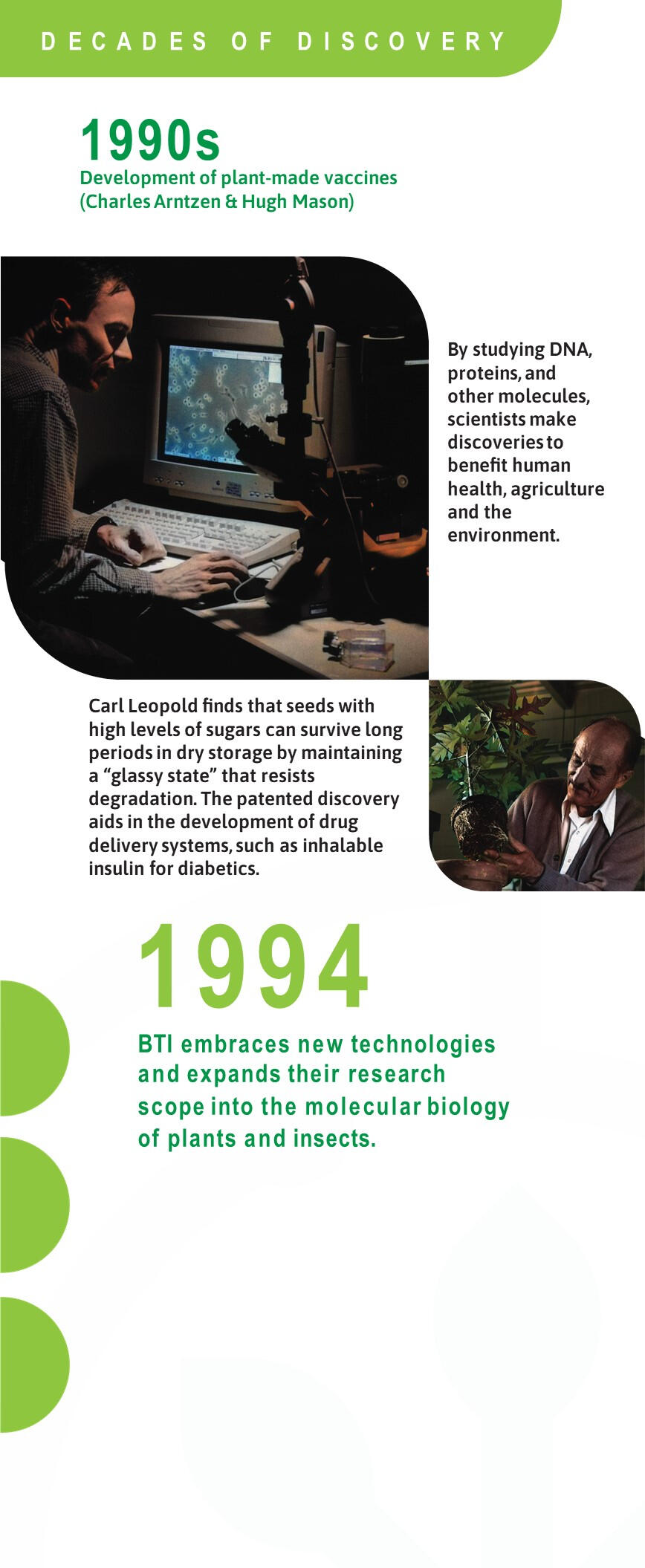
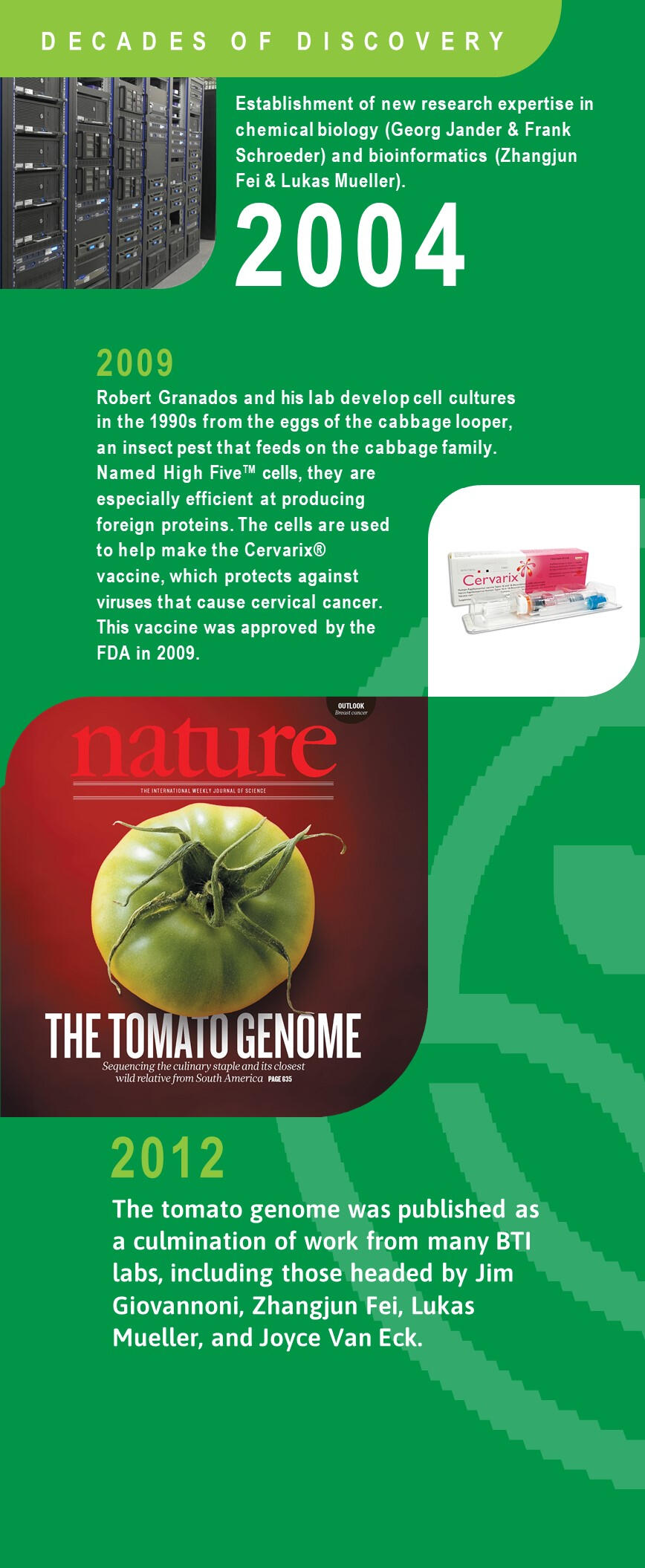
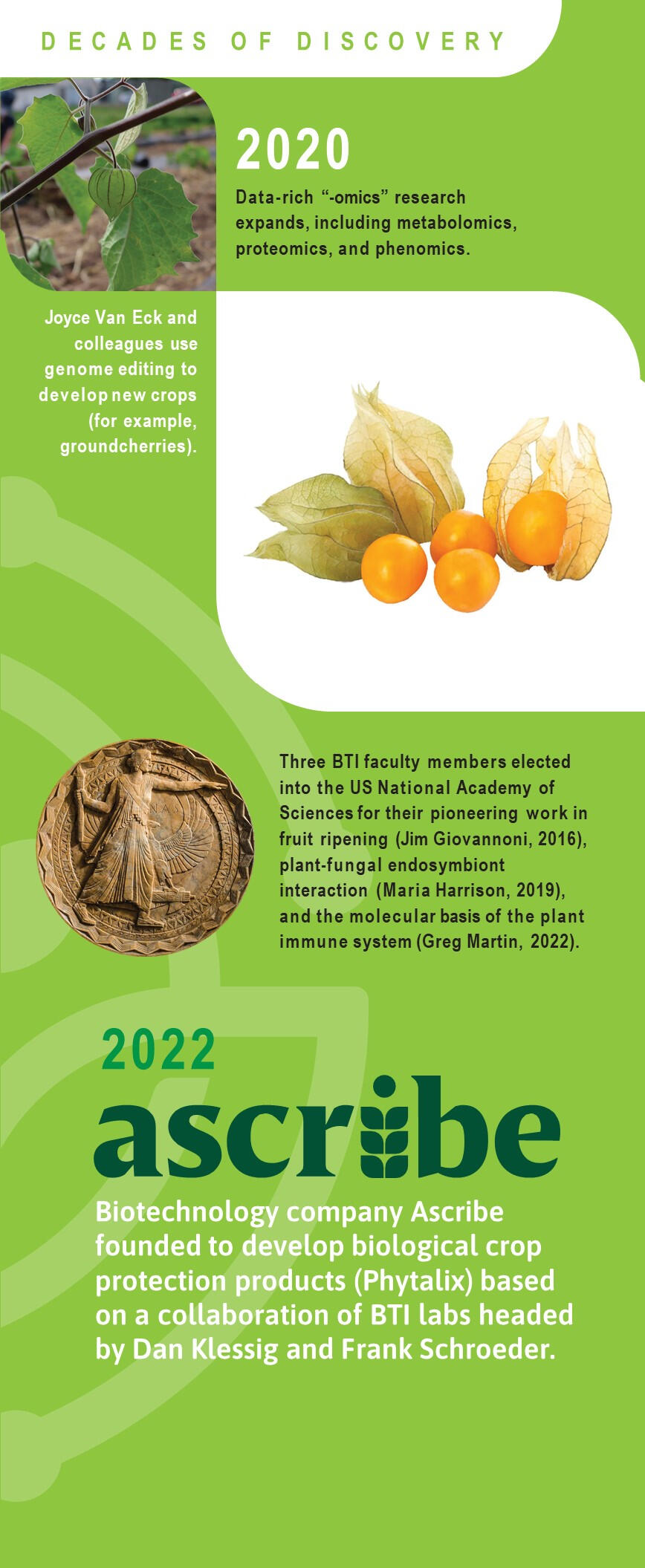
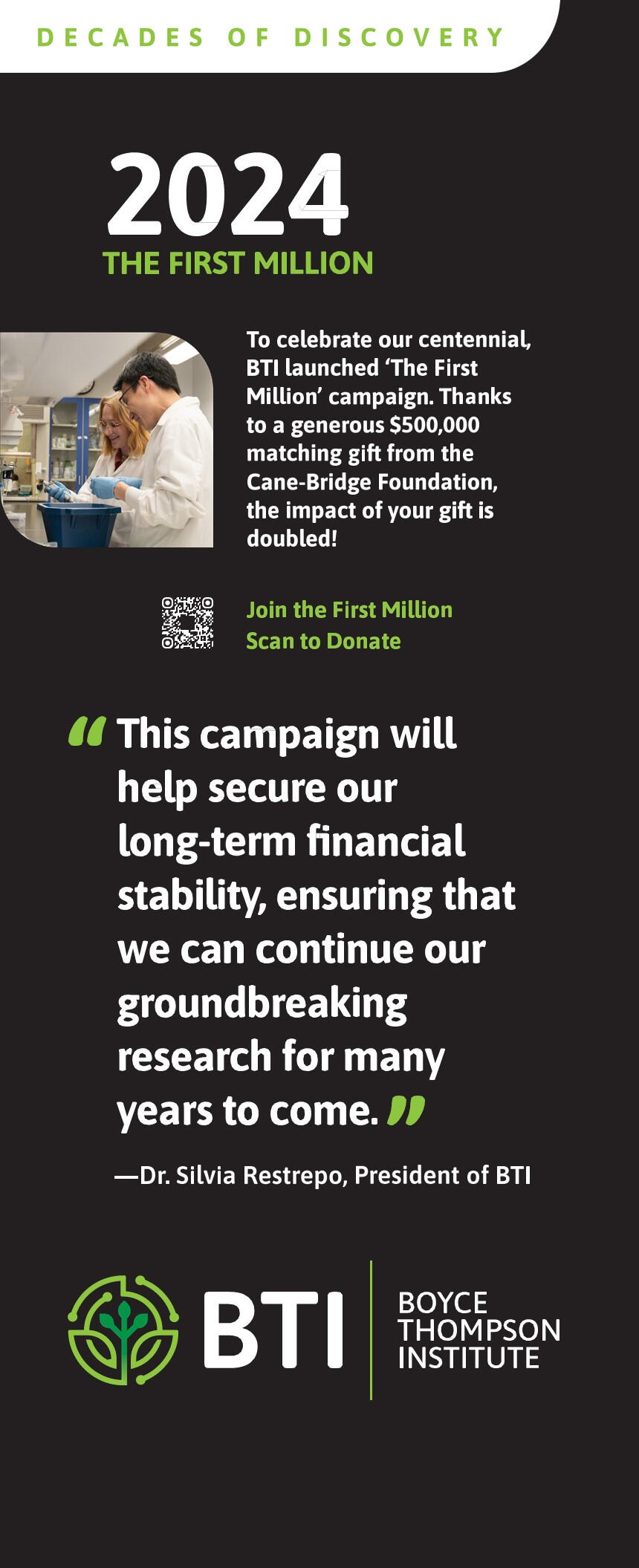
Oral Histories
March 20th, 4:30pm
BTI Auditorium
533 Tower Rd, Ithaca, NY 14853
You are invited to the first public screening of our Oral History project. An engaging 20-minute video offers intriguing glimpses and entertaining highlights into the personal journeys of ten BTI staff members.Accompanied by a Q&A session and reception with refreshments, this event invites attendees to delve deeper into the rich tapestry of our history.
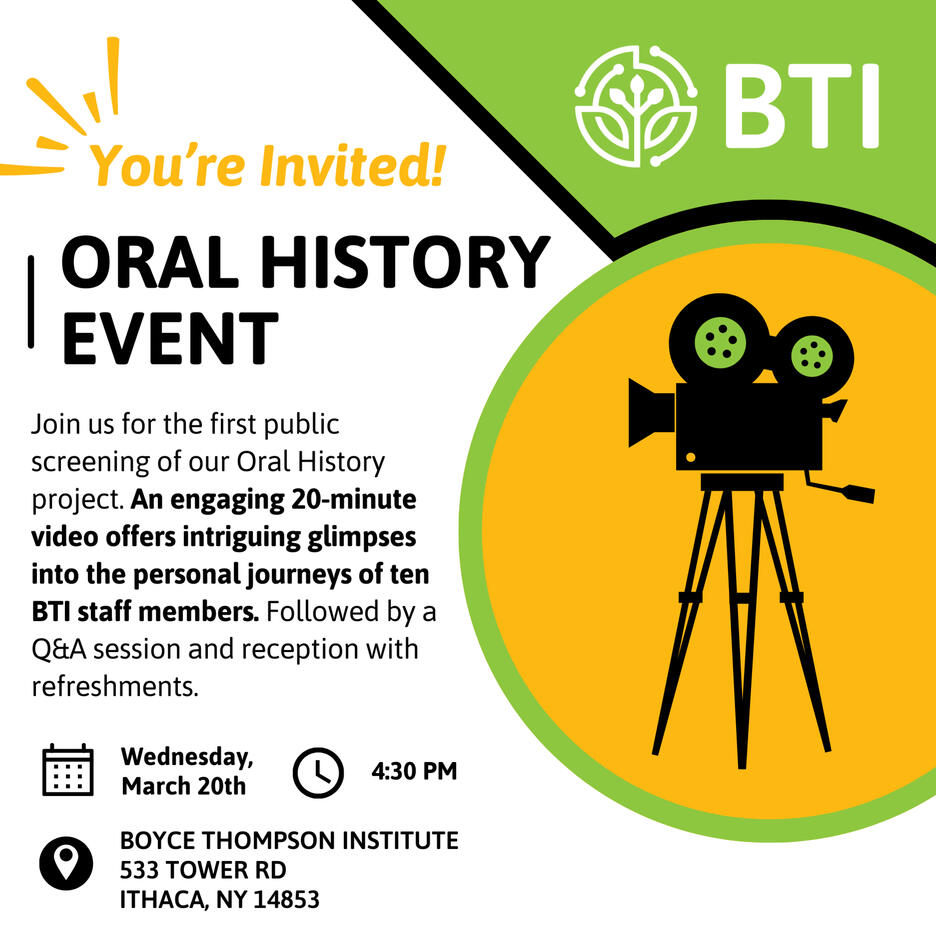
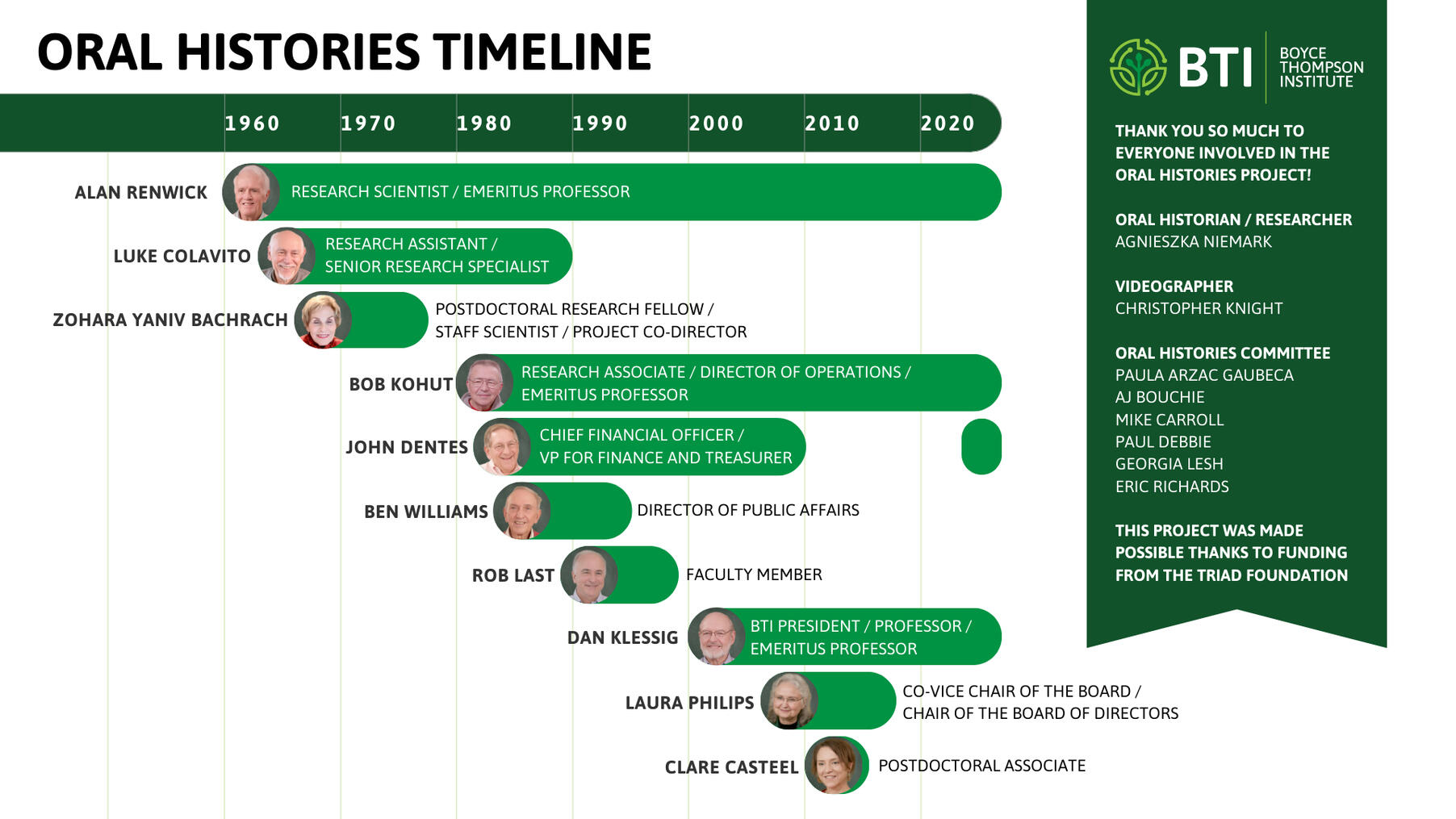
Click here to watch just the 20 minute Oral History Project video.
Questions for our participants?
Please enter them in the chat box!

Business After Hours
April 16th, 5-7pm
BTI Atrium
533 Tower Rd, Ithaca, NY 14853
We are privileged to host the Tompkins County Chamber of Commerce for their monthly Business After Hours event. Please note: this event is for Chamber members only.
This event is a showcase of BTI's community spirit and scientific fervor. Guests will be treated to light food, drinks, and tours, experiencing the wonders of plant science firsthand. It's a celebration of curiosity and a nod to the future, marked by innovative cocktails and engaging activities.
Flash Science
Join us for our version of the Three Minute Thesis Challenge, a unique research presentation format that challenges participants to explain their research to a non-specialist audience in three minutes or less. Hear about fascinating research in this rapid-fire competition.Immerse yourselves in this highly accessible, fast-paced, and pitch-like communication format - think Shark Tank, but for science!This event is a testament to BTI's commitment to educating and inspiring the next generation of scientists.
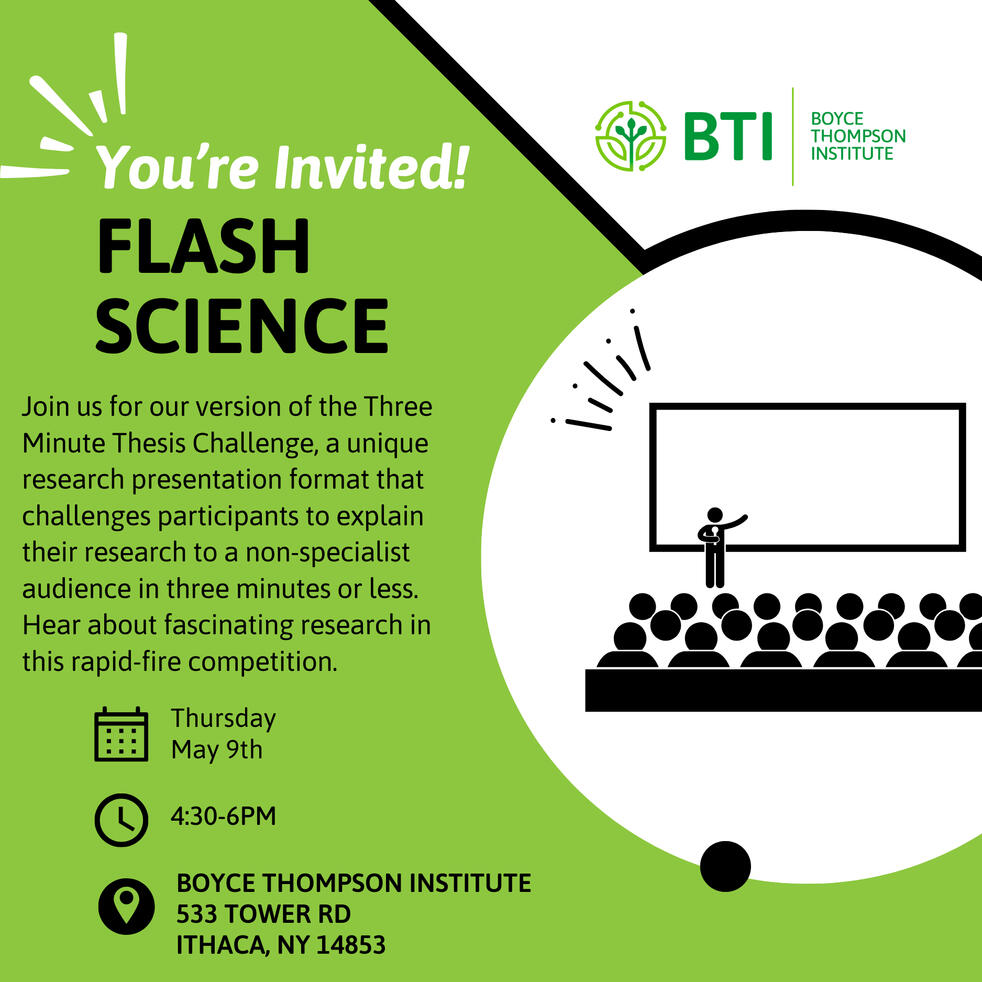
Tanner Robison: "A C-terminal extension in hornwort RbcS mediates pyrenoid phase separation in hornworts"Xuebo Zhao: "The demographic history and genomic diversification of bottle gourd"Evelyn Elkington: "Hybrid Vigor Project"Yanã Rizzieri: "Understanding the chromosome hoarding syndrome of homosporous ferns"Laura Kaminsky: "The ecological role of myxobacteria in the hyphosphere of arbuscular mycorrhizal fungi"Honghe Sun: "Construction and analysis of the graph-based pangenome of the Citrullus genus"Trevor Tivey: "Spatially Resolving The Cellular Landscape Of Arbuscular Mycorrhizal Symbiosis With Medicago truncatula and Rhizophagus irregulars"Anna Hermanns: "The Confluence of Structural Variants, Whole-Genome Expression Profiles, and Nutrient Accumulation in a Tomato Diversity Panel"Sarah Gartner: "Understanding c4 carbon capture in Setaria Viridis"Guillermo Jimenez Aleman: "Characterizing the cannabinoid biosynthesis pathway in the liverwort Radula obconica"
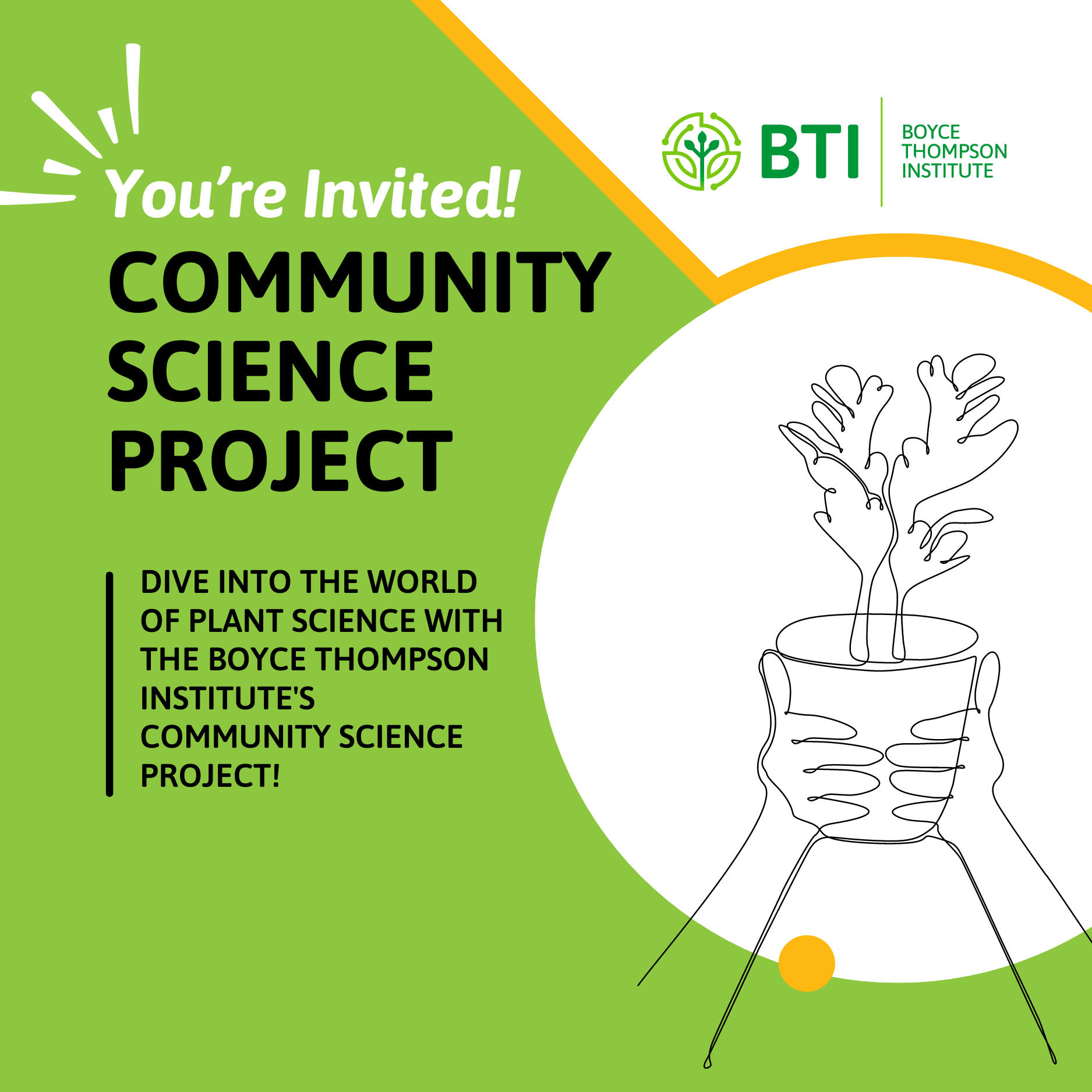
Community Science
June - OCTOBER
Join the BTI Community Science Project This Summer!Dive into the world of plant science with the Boyce Thompson Institute's community science project! From June to October, we're inviting you to help us study ground cherries and African eggplant right in your own backyard. With only 100 of each plant available, your participation will provide valuable insights into how these plants grow in different environments, which is essential for advancing our research.
What You'll Do:
(1) Register and Pick Up: Sign up to reserve one of the limited spots available. BTI is providing two plants—groundcherries and African eggplants—plus essential research materials. You'll need to provide a gardening space, either in the soil or an appropriately sized pot, ensure ample sunlight and water, and add trellising as they grow.(2) Plant and Observe: Plant your ground cherries or African Eggplants, watch them grow, and note key developments like harvest times and insect activity.(3) Share Data and Photos: Use our simple JotForm to send us your observations and photos throughout the summer.Why It Matters:
Your participation bridges the gap between scientific research and community knowledge, helping us understand plant behaviors in real-world settings. This project not only advances science but also makes plant research accessible and engaging, reducing disparities in plant awareness.We’re excited to collaborate with you! Together, we can make significant contributions to plant science, learning and growing every step of the way.We will be unable to accommodate anyone who shows up without registering. Register now and be a part of this exciting venture!
BTI Family Picnic
July 24th
Hopshire Farm
1771 Dryden Rd, Freeville, NY
The BTI Family Picnic is an annual celebration dedicated to appreciating the hard work and dedication of our staff. It's a time for our internal community to come together, relax, and enjoy a fun-filled day with various activities and treats.Please note: This event is exclusively for BTI staff and their families.
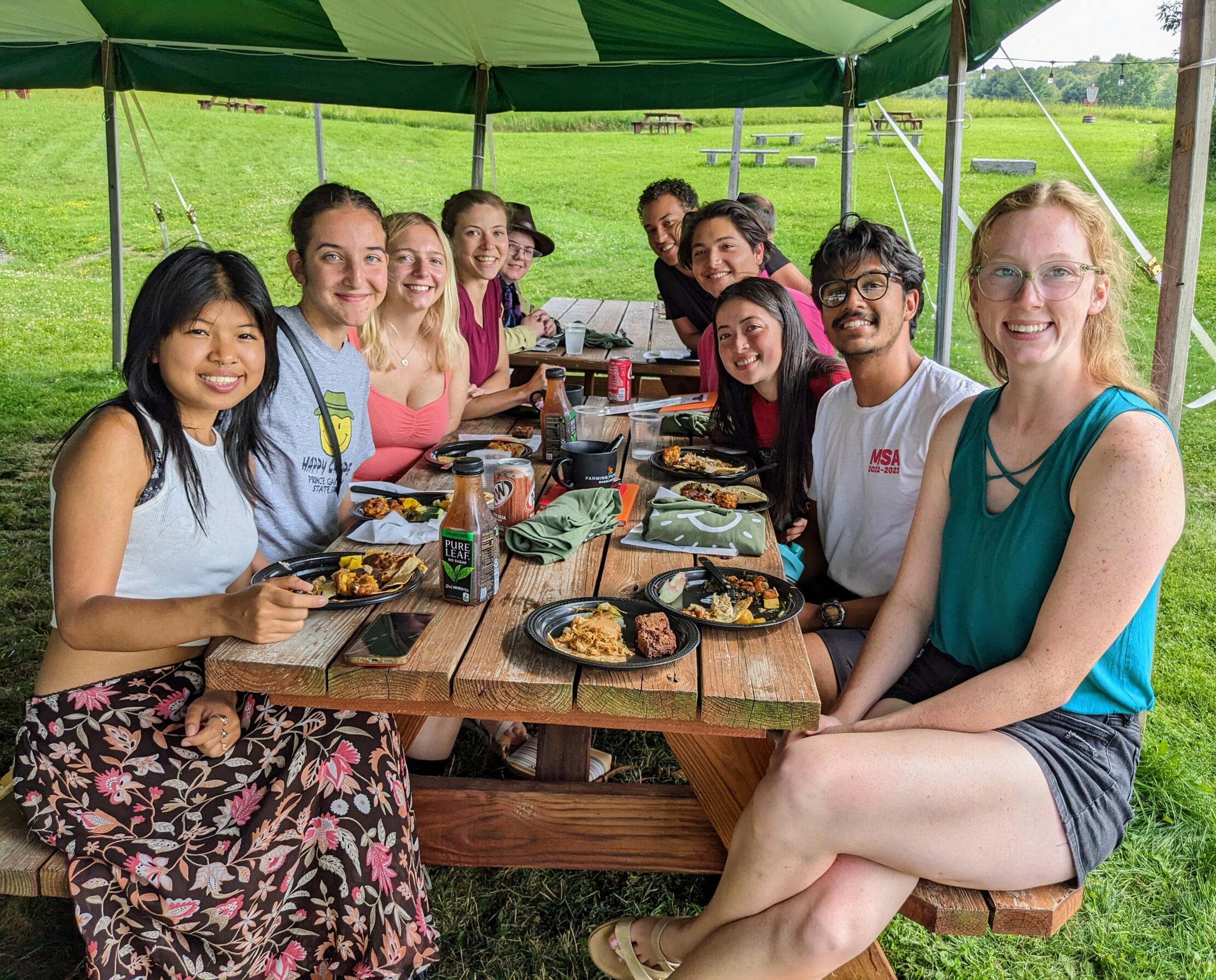
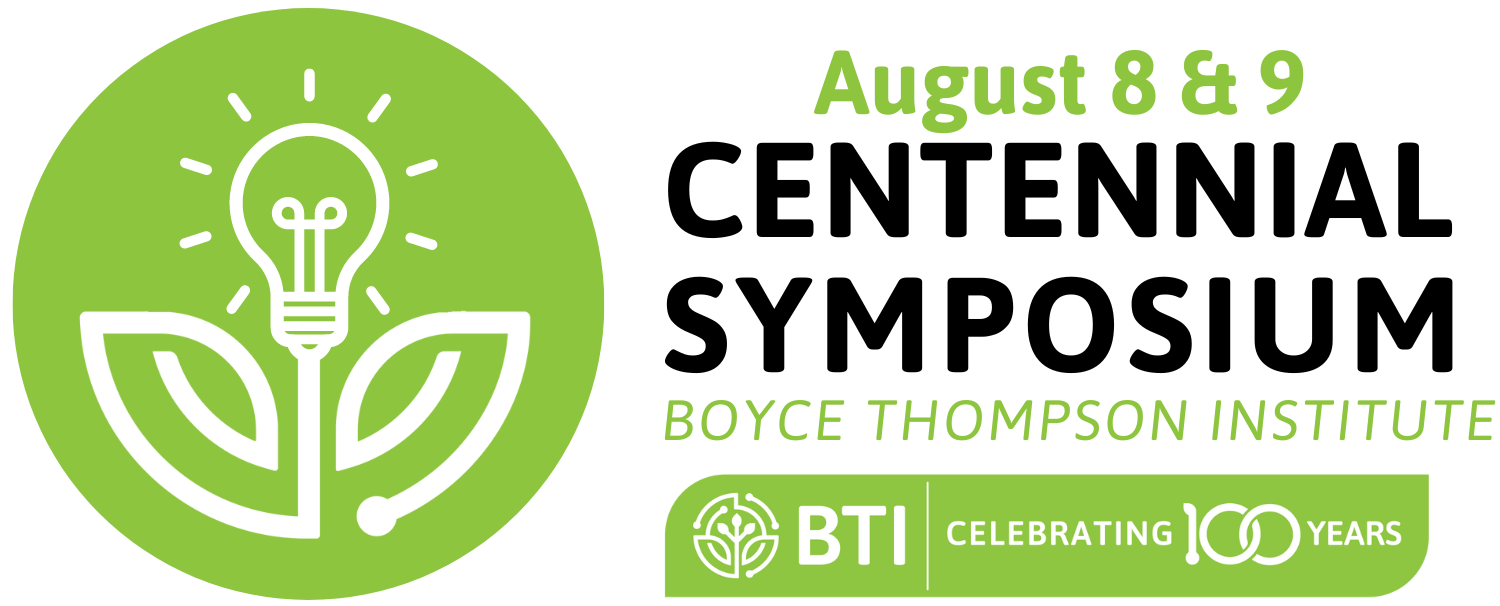
August 8th-9th
Boyce Thompson Institute
We are delighted to announce our 2024 Centennial Symposium, which will take place on August 8 and 9! This special two-day event promises to be an enriching experience filled with insightful talks, engaging discussions, and opportunities to connect. Our Institute only turns 100 once!
Silvia Restrepo
Alexa Schmitz
Eddie Watkins
Megan Truesdail honors the Kohuts
Daniel Voytas
Jim Giovannoni
Georg Jander
Magdalena Julkowska
Maria Harrison
Anna Hermanns
Amber Hotto
Andrew Nelson
Miguel Pineros
Maricelis Acevedo
Zhangjun Fei
Eric Richards
Li'ang Yu
Aaron Callahan
Trevor Tivey
Career Panel
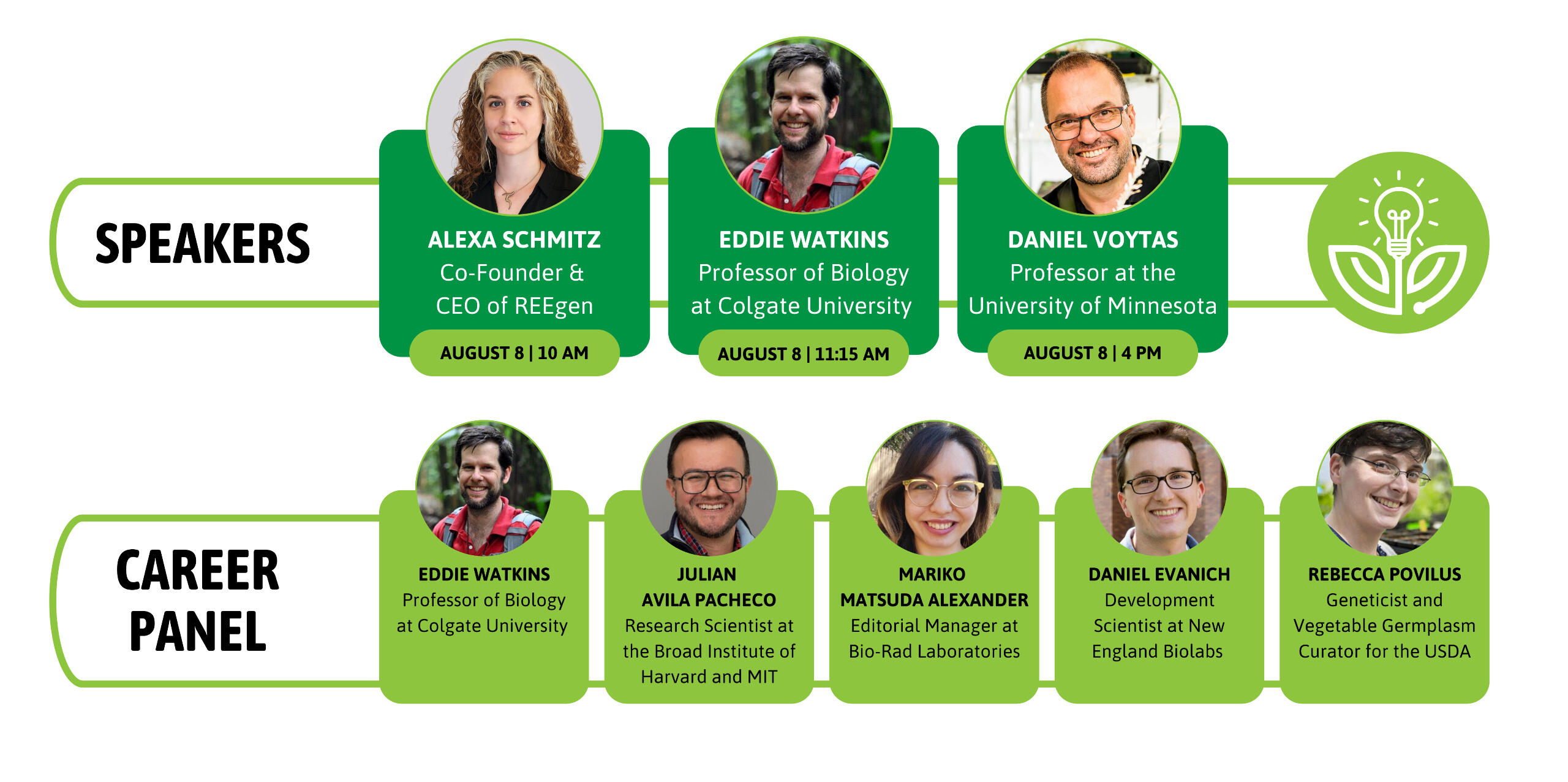
Speaker Bios:
Alexa Schmitz – Co-Founder & CEO of REEgen
Daniel Voytas – Professor at the University of Minnesota
Eddie Watkins – Professor of Biology at Colgate University
Career Panel Speaker Bios:
Eddie Watkins (Professor of Biology at Colgate University)
Julian Avila Pacheco (Research Scientist at the Broad Institute of Harvard and MIT)
Mariko Matsuda Alexander (Editorial Manager at Bio-Rad Laboratories)
Daniel Evanich (Development Scientist at New England Biolabs)
Rebecca Povilus (Geneticist and Vegetable Germplasm Curator for the USDA)
REU Poster Sessions:
| Session 1 (12:30 - 2:15 pm) | Session 2 (2:15 to 4:00 pm) |
|---|---|
| Carrington Thompson | Ying Gan |
| Ruth Conlin | Matthew Lettow |
| Spencer Ervin | Bryan Rosado-Maldonado |
| Alexander Fenlon | Hannah Rockwell |
| Charlie Cuttino | Venus Kajangu |
| Kiara Gomez-Cruz | Matilda Bergsten |
| Alex Chavez | Darren Leopold |
| Gillian Doty | Brenna Lucio-Belbase |
| Jordan Hunter | Anh Mai |
| Leland Russell | Makayla Ritko |
| Tamara Bouchrd | Ellie Kreider |
| Henry Becuti Ortiz | Joshua Kwayke-Minott |
| Connor Lafo | Nathan Schuessler |
| Katie Carson | Ana Sofia Castellanos Mosquera |
| Annie Voss | Etienne Exantus |
| Lara Jacobowitz | Nat Michaels |
| Aminah Coleman | Amitha Karuppiah |
| Clare Edminster | Stella Macfarlane |
| Vivian Molloy | Vital Nyabashi |
| Sanya Sitlani | Connor Donahue |
| Rachel Yee | Sora Haagensen |
| Alexandra Carabetta | Aaron Alexander |
| Karen Salazar | Rocky Shao |
| Nora McSwain | Nicolas Velasco Sanchez |
| Liz Cortes |
Mariko Matsuda Alexander
Editorial Manager at Bio-Rad Laboratories
Mariko Alexander is the Editorial Manager in Life Science Global Brand Creative Services at Bio-Rad Laboratories. She has a BSc in Soil and Crop Science from Colorado State University, and later went on to obtain a PhD in Plant Pathology from Cornell University, where she studied host-virus interactions and structural biology of viruses in the family Luteoviridae in the lab of Dr. Michelle Heck. Following completion of her PhD in 2019, Mariko was hired as a Science Editor at Bio-Rad, where she worked for several years before being promoted to Editorial Manager. Mariko's team of full-time and contract editors work with the rest of the Brand Creative Services department to produce videos, podcasts, articles, and other multimedia marketing materials.

Alexa Schmitz
Co-Founder & CEO of REEgen
Dr. Alexa Schmitz is the CEO and co-founder of REEgen, a bio-mining startup spun out of Cornell University that is developing a system for sustainable and clean biomanufacturing of rare earth elements. Alexa received her PhD from Cornell University where she worked with Dr. Maria Harrison at Boyce Thompson Institute, investigating the role of small peptides in plant-fungal signaling during mycorrhizal symbiosis. After her PhD, she continued her work at Cornell in the critical minerals space as a Cornell Energy Systems Postdoctoral Fellow in the Lab of Dr. Buz Barstow. There she first began working on genetically engineering biological mechanisms for rare earth element recovery. Since co-founding REEgen in 2022, Alexa has been able to work full time for the company with support from a two-year fellowship from Activate, a deep-tech startup accelerator program that provides the company with mentorship, funding, and access to venture capital. When not answering endless emails and talking to investors, Alexa enjoys paddleboarding on Cayuga Lake and renovating her historic NY home.

Rebecca Povilus
Geneticist & Vegetable Germplasm Curator for the USDA
Rebecca Povilus is a Geneticist and Vegetable Germplasm Curator for the USDA, Agricultural Research Service, Plant Genetics Research Unit in Geneva, NY. She is broadly interested in the evolution of plant development, with special interest in understanding how seeds develop, and how those developmental processes have evolved across the vast diversity of flowering plants. Dr. Povilus was previously a post-doctoral researcher in the Ghering lab at the Whitehead Institute. Much of her work has focused on the reproductive biology and seed development in the water lily Nymphaea thermarum. She is interested in combining new technologies and techniques in genetics and molecular biology to study how genes function, with a firm understanding of plant morphology, anatomy, and development.
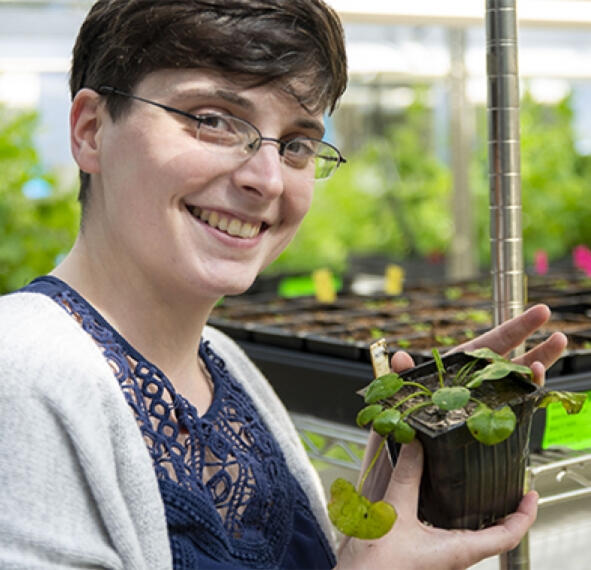
Daniel Evanich
Development Scientist at New England Biolabs
Daniel received a bachelor’s degree in Botany from Connecticut College in 2015 where he worked on auxin biosynthesis in Populus. After moving to Cornell, he joined Jim Giovannoni’s lab studying the regulation of fruit ripening in tomato with an emphasis on epigenetic and transcriptional control. After earning his Ph.D. in Plant Biology in 2021 he joined New England Biolabs as an NGS Development Scientist in the Applications and Product Development Group. His primary focus is developing next generation sequencing products for epigenetics applications, including enzymatic methods for detecting 5-methylcytosine and 5-hydroxymethylcytosine.

Eddie Watkins
Professor of Biology at Colgate University
James “Eddie” Watkins is a Professor of Biology at Colgate University in Upstate New York. He completed his MS at Iowa State with Donald Farrar where he studied the systematics and ecology of Thelypteris. He completed his PhD at the University of Florida with Michelle Mack and Stephen Mulkey where he was the first biologist to employ modern physiological tools in the study of fern gametophyte physiology. He spent two years at Harvard University as a Mercer Fellow at the Arnold Arboretum where he explored the role of leaf hydraulics in tropical fern ecology and evolution. He is past president of the American Fern Society and is actively engaged in research on the ecophysiological consequences of the independent gametophyte generation in ferns. Dr. Watkins was also recently awarded the Charles E. Bessey Award from the Botanical Society of America,
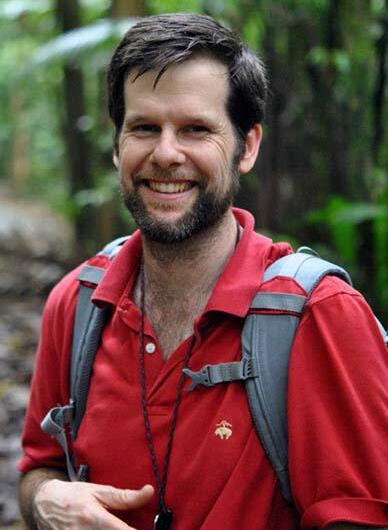
Julian Avila Pacheco
Research Scientist at the Broad Institute of Harvard and MIT
Before joining the Broad Institute in February 2015, Julian Avila-Pacheco served as a research associate at the Howard Hughes Medical Institute in the Torii Lab in the Biology Department of the University of Washington. Originally trained as a plant biologist, his work previously focused on the role of posttranslational protein modifications (phosphorylation and ubiquitination) in cell signaling using a variety of biochemical, molecular, and genetic approaches. As a Scientist in the Broad Institute Metabolomics Platform, Dr. Avila develops methods for the analysis, interpretation, and annotation of metabolomics data generated using liquid chromatography tandem mass spectrometry (LC-MS). A key focus of his research is discovering and characterizing novel metabolites associated with a broad range of disorders such as inflammatory bowel disease (IBD), metabolic disease, and cancer.

Daniel Voytas
Professor at the University of Minnesota
Dr. Daniel Voytas obtained his A.B. in Biology at Harvard College and his Ph.D. in Genetics with Fred Ausubel at Harvard Medical School. Now, at the University of Minnesota, he is a Distinguished McKnight University Professor and the founding Director of the Center for Precision Plant Genomics. Dr. Voytas’ research focuses on developing methods to edit plant genomes. His laboratory developed a powerful genome editing reagent – Transcription Activator-Like Effector Nucleases (TALENs) – which was heralded by Science magazine as one of the top ten scientific breakthroughs of 2012. Dr. Voytas’ lab is currently optimizing methods for efficiently making targeted genome modifications in a variety of plant species to advance basic biology and develop new crop varieties. In addition to his position at the University of Minnesota, Dr. Voytas co-founded Calyxt, an agricultural biotechnology company that used gene editing for crop improvement. In 2019, Dr. Voytas was elected to the National Academy of Sciences.
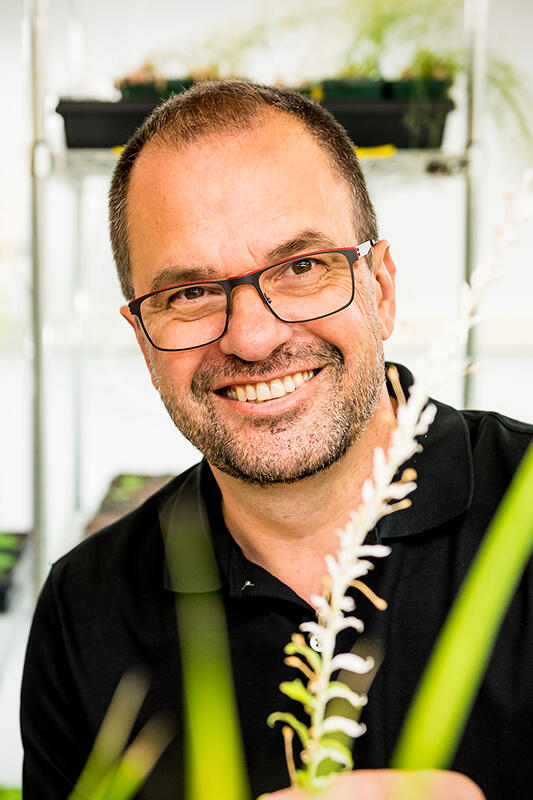
Contact
Questions? We'd love to hear from you!
Thank you
Our team will respond as soon as possible. Thanks for reaching out!
VISIT BTI
Boyce Thompson Institute
533 Tower Rd, Ithaca, NY 14853
View map
📅 Event Details:
Our events are open to all, free of charge! Check here for RSVP links a couple weeks before the event to ensure your spot. Most events are casual, with attire specifics noted for special occasions.🚗 Transportation and Parking:
Daytime (7:30 am - 5 pm): Utilize Parkmobile lots for parking. Find locations here.
Evening (after 5 pm): Enjoy complimentary parking on campus, including the lot adjacent to our building.🚌 TCAT Bus to BTI
TCAT buses serve the Boyce Thompson Institute, stopping directly in front of our main entrance. This is an eco-friendly option for visitors, though be mindful of possible delays.
Plan: Google Maps for TCAT routes to BTI. Enter your start point and destination.
Fares: $1.50 for adults, $0.75 for eligible reduced fares. Exact change or Tcard swipes only. More fare info HERE
Note: Check TCAT’s website or Google Maps in advance for schedules and possible changes.♿ Accessibility:
Our venue welcomes everyone, featuring a wheelchair-friendly entrance and ADA-compliant facilities. During Centennial events, the front door of BTI will be open. Please note: A key card is required to enter the building outside event times - Please contact communications@btiscience.org to coordinate your visit.✈️ Flight Information:
Ithaca Tompkins International Airport (ITH): Serviced by major airlines, including American, Delta, and United.
Alternative Airports: Consider Syracuse (SYR) or Elmira (ELM) for more flight choices.🏨 Accommodations:
The Canopy Hotel: BTI visitors receive special rates. Conveniently located downtown, ensuring a comfortable stay. Book now.🚖 Getting Around Ithaca:
Car Rentals: Choose from Enterprise, Hertz, and Avis, which are available both at the airport and downtown.
Taxi & Ride-Sharing: Ithaca Dispatch and Collegetown Cab, along with Uber and Lyft, provide round-the-clock service.
Public Transportation: TCAT buses offer an eco-friendly way to explore Ithaca and Tompkins County.🌳 Discover Ithaca, NY:
Immerse yourself in the area's natural beauty and cultural offerings:
Cornell University: Visit the campus, Botanic Gardens, and Johnson Museum of Art.
Ithaca Commons: The city's vibrant hub, filled with shops, eateries, and entertainment.
Cayuga Lake & Wine Trail: Enjoy water sports and local wines.
State Parks: Explore Taughannock and Buttermilk Falls for outdoor adventures.
Sciencenter & Farmers Market: Perfect for family entertainment and local flavors.Contact Us:
For more information or assistance, please reach out via email, or follow us on social media.
Please join us on Tuesday, March 26th, 2024 from 10-11:00am in the BTI Auditorium for the next speaker in our special Centennial Series, Dr. Rob Last.
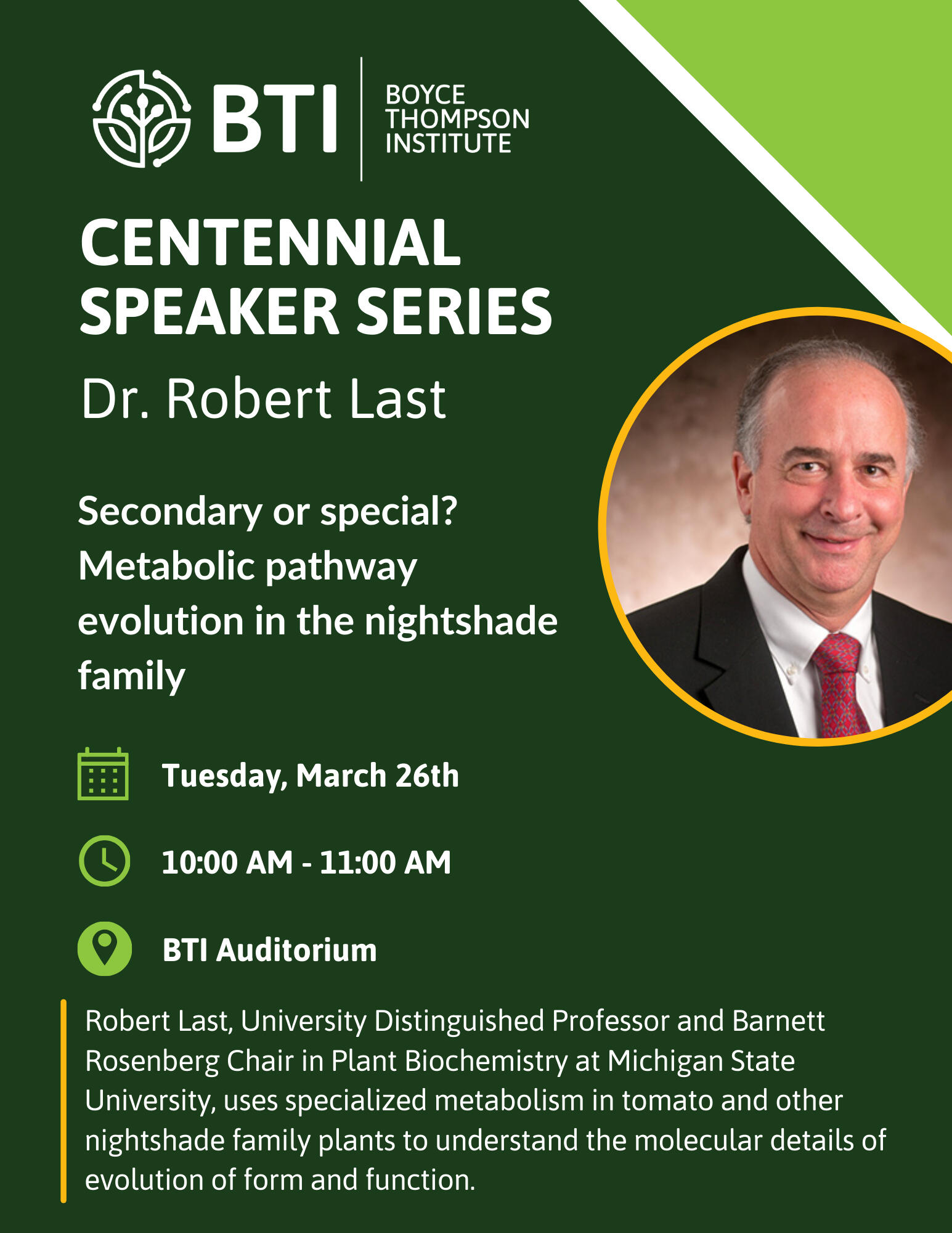
Centennial Stories
Our centennial celebration has been a chance for past and present members of the BTI community to reflect on their time at the Institute. Enjoy these stories that have been shared with us!
To submit your own BTI memory, please email communications@btiscience.org
Oral History Project
Alan Wood
Bob Kohut
Response of Plants to Interacting Stress (ROPIS) Project
Prudhoe Bay oil field in Alaska
Oral History Project
Response of Plants to Interacting Stress (ROPIS)
The Response of Plants to Interacting Stress (ROPIS) project was the single largest and most expensive research effort in the Environmental Biology Program. The picture of the field crew putting the plastic on the chambers gives you an idea of their size; this was al “All Hands” evolution.Due to the complexity of the construction process, the chambers were assembled at the BTI field research site but away from the specific locations at which they were to be used. They were so large and heavy that a helicopter was used to move them onto the field sites where the ozone and acid rain exposures would take place.The project was named ROPIS (Response of Plants to Interacting Stress) and ran from 1986 through 1991. It was funded by The Electric Power Research Institute, The Empire State Electric Energy Research Corporation, and the US Forest Service with an overall budget of about $4 million.The problem that drove the project was that red spruce trees in the Adirondacks in NY and the Red and White Mountains in NH and VT were declining from some unknown stresses. This was in the 1980s and ambient levels of ozone were high, and acid rain was also a concern.The study was designed to assess the individual and interactive effects of these two pollutants on the growth, physiology and nutrition of red spruce sapling trees. It also assessed the effects of acid rain on the chemistry of the soil in which the trees were growing.Red spruce saplings about 1 meter tall were obtained from near Millenocket, Maine, an area in which there were no reports of the trees being in decline. Trees were dug with a root ball of native soil that was kept as intact as possible. Trees and their root balls and native soil were placed into pots approximately 30” in diameter and 24” deep. The trees were placed into 18-wheeler trucks, driven overnight to the BTI field research site in Ithaca and unloaded by other Environmental Biology staff.The experiment used 12 chambers that were each 24 ft long (3 8-ft sections), 12 ft tall and 8 ft wide. Each chamber received one of four ozone treatment levels; 0.5X ambient, ambient, 1.5X ambient or 2.0X ambient Inside each chamber there were three sections, each section holding two red spruce trees in their pots. Each chamber had a top cover that could be drawn closed to exclude ambient rain.Each of the three 8 ft X 8 ft sections in a chamber received a different acid rain treatment at pH of 3.1, 4.1 or 5.1, and contained two trees in pots that were sunken to ground level in excavated holes. One pot rested on load cells so the tree, soil and soil water could be constantly weighed. This allowed us to know how much rain was applied, how the pot drained and how the tree used water by transpiration.That pot also had tension lysimeters buried at three depths in the soil profile so that water percolating through the soil profile could be collected for chemical analysis. Two cups were placed on top of the soil to collect water that had passed through the canopy of the trees.Thus, we were able to assess changes in chemistry from that of the rain we applied, to throughfall that had passed through the tree canopy, to how it changed as it moved through three depths of soil in the pot. Small samples of tree needles were also periodically obtained. Collectively, these samples allowed the complete cycle of precipitation biogeochemistry (rain applied, tree foliage, throughfall onto the soil, and soil water at three depths) to be assessed. This part of the study was conducted in collaboration with Natural Resources at Cornell.Rates of photosynthesis and respiration were regularly assessed for the trees. All trees were harvested (some at 3 years and all at 4 years) and biomass and nutrient composition assessed.Basically, the research showed that neither the ozone nor the acid rain produced a significant impact on the trees’ growth or physiology. Red spruce did not show the symptoms of decline that were observed in the field.
Prudhoe Bay oil field in Alaska
The facility near which the study was conducted was known as the Central Compressor Plant (CCP). When oil came to the surface at the wellheads it had natural gas mixed with it. The gas was separated and piped to the CCP where some was used as fuel to generate electricity for all the oil field. The rest of the gas was compressed and injected back into the ground. The injected gas was used to drive the underground oil through the rock strata toward wellheads where the oil was brought to the surface.Tundra ecosystems are generally low in nitrogen so there was some concern about whether the oxides of nitrogen in the exhaust from the gas compressor plant was introducing enough nitrogen to the near-by tundra to alter the vegetation there. We conducted a 5-year assessment of tundra vegetation along a dispersion gradient of about 3 miles from the compressor plant to determine whether impacts were occurring. We found no effects on the physiology of the plants we examined or on the composition of the plant communities on the assessment plots.One thing about Environmental Biology — I did not do much work hunched over a lab bench. Five years working at Prudhoe Bay in Alaska. Five years studying the effects of ozone on vegetation at Acadia National Park in Maine. A total of 10 years working at the BTI field site first studying the effects of ozone on agricultural crops and later the effects of ozone and acid rain on trees. Oh man, those were the days!!!!
